First Computer MPC13A Notebook Computer with DSSS Data Transceiver User Manual PROPRIETARY NOTICE AND LIABILITY DISCLAIMER
First International Computer Inc Notebook Computer with DSSS Data Transceiver PROPRIETARY NOTICE AND LIABILITY DISCLAIMER
Contents
- 1. User Manual 1of 2
- 2. User Manual 2 of 2
User Manual 2 of 2
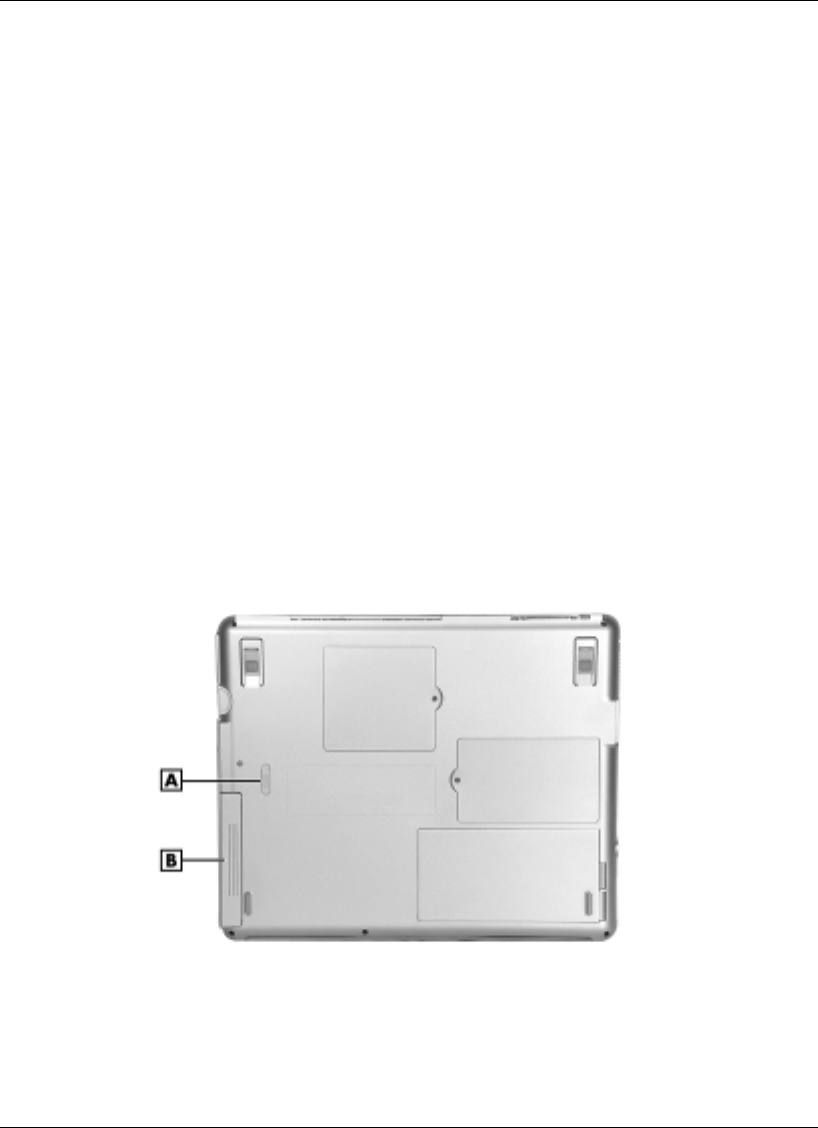
Using the System Drives and Bays 5-5
Installing a Device in the NEC Modular Bay Slot
Use the following steps to install a device in the NEC Modular Bay slot.
1. Use the Phoenix BaySwap utility or power off the system.
2. Remove the Modular Bay device or weight-saving module from the Modular Bay
slot.
3. Align the device in the NEC Modular Bay slot and push it in until it fits securely
into the bay. Make sure the latch secures the device.
4. Press the Power button to power on or resume operation.
Removing a Device from the NEC VersaBay IV Slot
Use the following steps to remove a device from the NEC VersaBay IV slot.
1. Use the Phoenix BaySwap utility or power off the system.
2. Close the LCD panel and turn the system over.
3. Locate the NEC VersaBay IV release latch (see the following figure).
Locating the NEC VersaBay IV release latch
A – NEC VersaBay IV Release Latch B – NEC VersaBay IV Device
4. Slide the latch toward the back of the system and hold it.
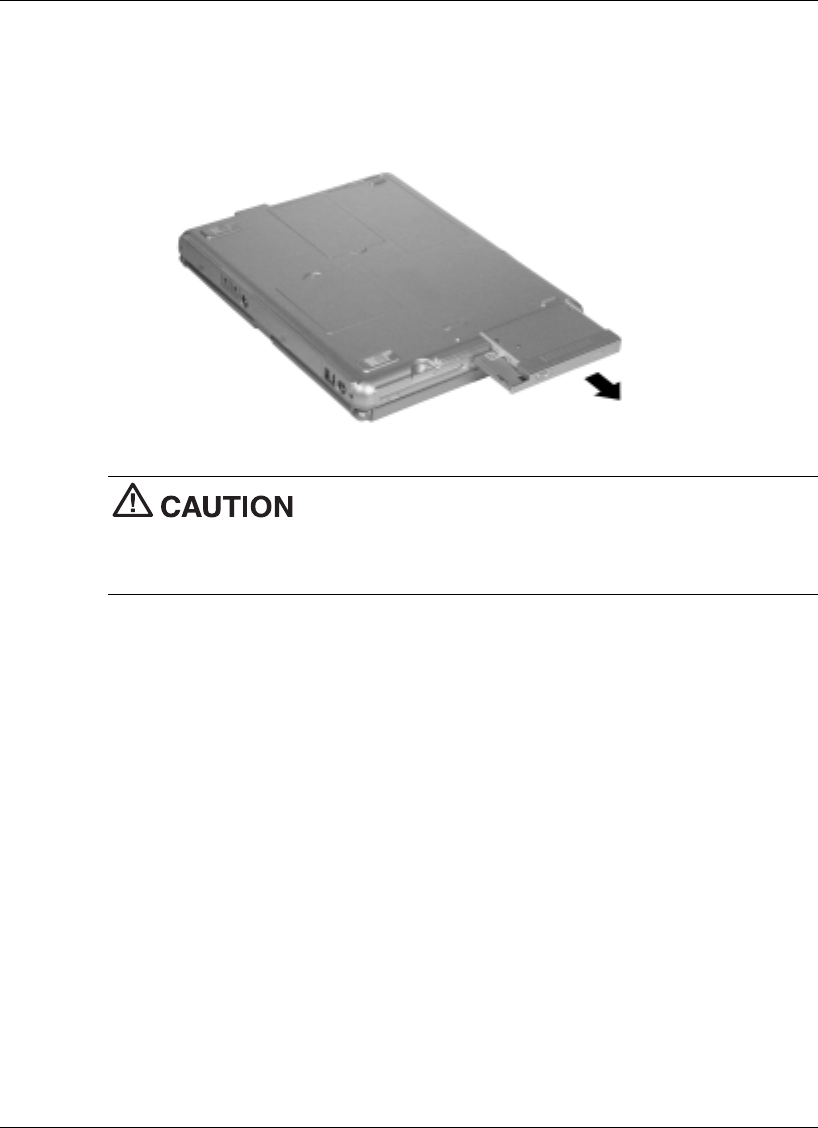
5-6 Using the System Drives and Bays
5. Grasp the edge of the NEC VersaBay IV device and pull the device out of the
system.
Removing a device from the VersaBay IV slot
Always install the weight-saving module that ships with your
system in the VersaBay IV slot if no VersaBay IV device is installed in the slot. See
“Installing a Device in the NEC VersaBay IV Slot” for instructions on installing the
module.
Installing a Device in the NEC VersaBay IV Slot
Use the following steps to install a device in the NEC VersaBay IV slot.
1. Use the Phoenix BaySwap utility or power off the system.
2. Remove the VersaBay IV device or weight-saving module from VersaBay IV slot.
3. Align the device in the NEC VersaBay IV slot and push it in until it fits securely
into the bay.
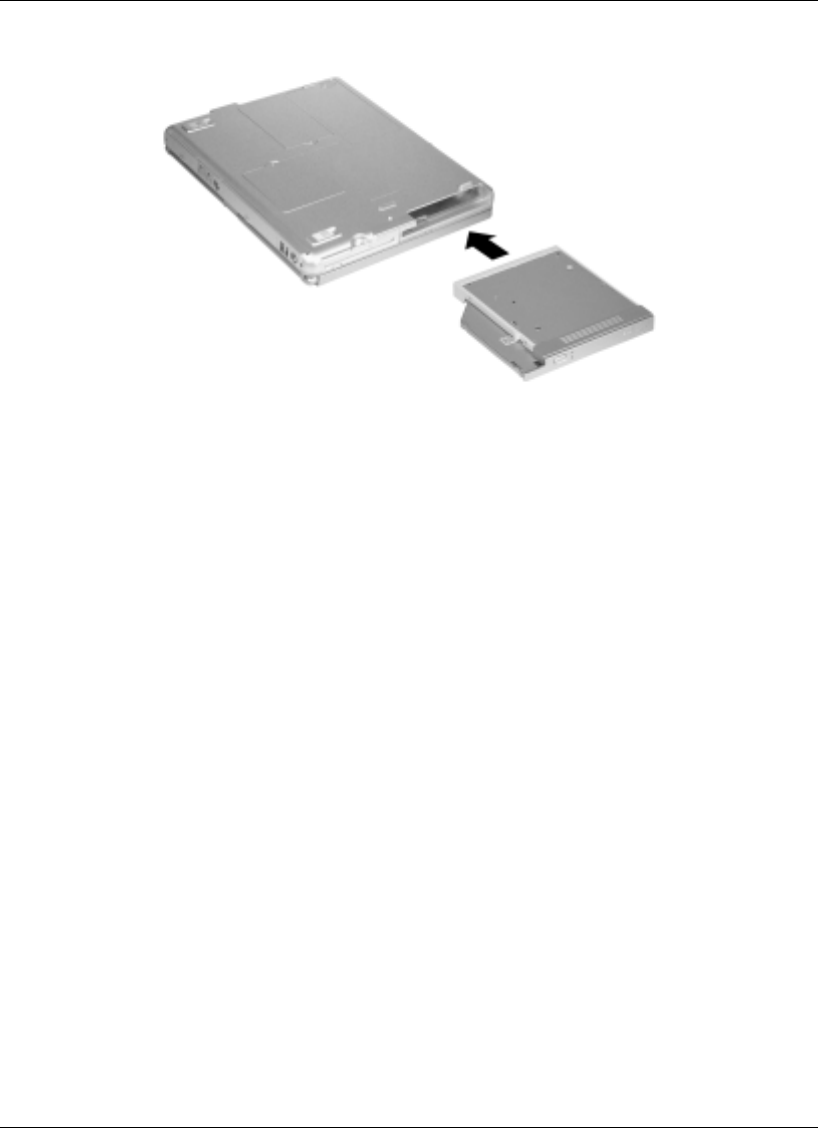
Using the System Drives and Bays 5-7
Inserting a device into the NEC VersaBay IV slot
4. Turn the system over and open the LCD panel.
5. Press the Power button to power on or resume operation.
Variable-Speed CD-ROM Drive
Your NEC Versa notebook might ship with a 24X maximum/12X minimum variable-
speed CD-ROM drive. The CD-ROM drive is assigned an available drive letter. Use
the CD-ROM drive to load and start programs from a compact disc (CD) or to play
your audio CDs. The CD-ROM drive is fully compatible with Kodak™ multisession
Photo CD™ discs and standard audio CDs.
The CD-ROM drive operates at different speeds depending on whether the CD you are
using contains data or music. This allows you to get your data faster and to see
smoother animation and video. Note that data is read at a variable transfer rate
depending on its location. For example, the maximum rated speed is generally achieved
only when reading the outermost track on a completely filled CD.
The CD-ROM drive offers the following features (see the following figure).
! Status LED — Lights during data read operations. Do not eject the CD or turn off
the NEC Versa notebook when the indicator is lit.
! Emergency Eject Hole — Allows you to manually remove a disc from the
CD-ROM drive if the eject function is disabled by software or a power failure.
To remove a disc, insert the end of a paper clip into the eject hole, and push in until
you hear a click. Manually open the drawer.
! Eject Button — Ejects the CD tray. Press this button when power is on to insert a
CD into or remove a CD from the drive.
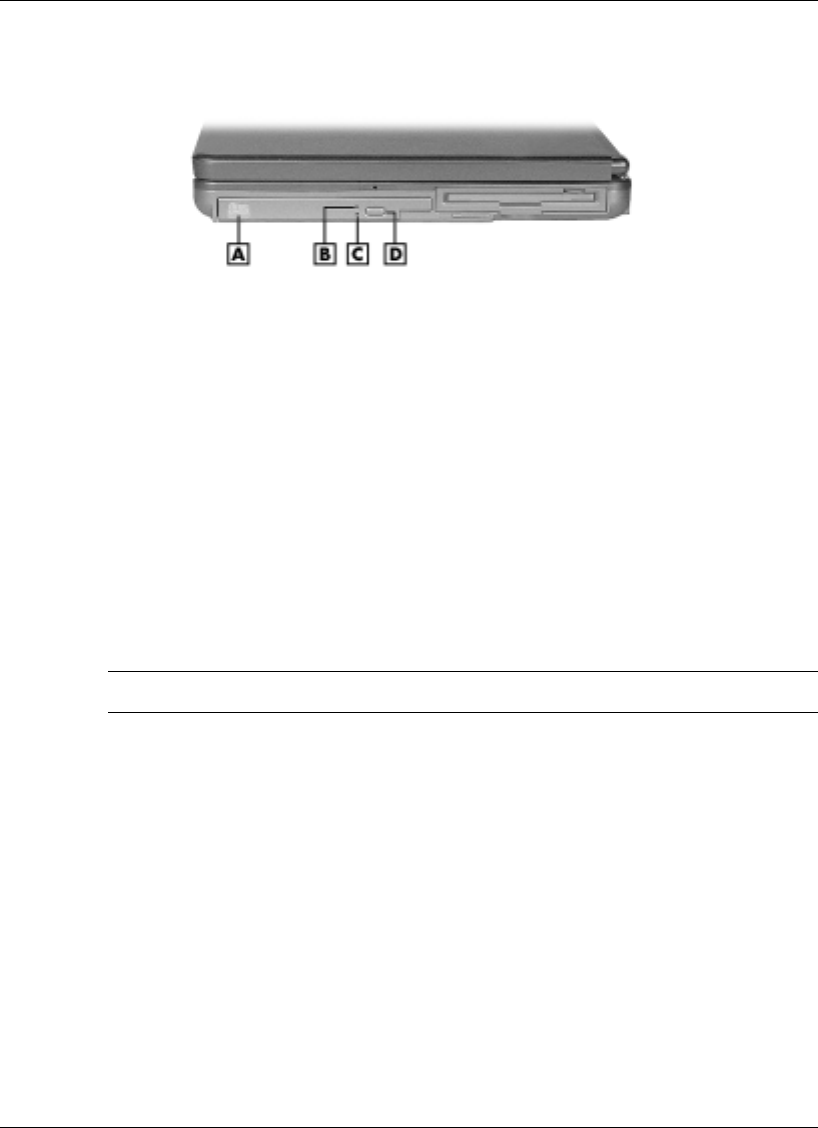
5-8 Using the System Drives and Bays
CD-ROM drive features
A – CD-ROM Drive C – Emergency Eject Hole
B – CD-ROM Drive Status LED D – Disc Eject Button
CD Loading
To insert a CD into the CD-ROM drive, follow these steps.
1. With system power on, press the Eject button. The CD tray emerges a short way
out of the drive door.
2. Gently pull the tray out until you can easily position a disc in the tray.
3. Put your CD, printed side up, into the circular impression in the tray.
4. Push the CD tray in until it clicks shut.
Note Some CDs vibrate when playing. This does not affect the CD-ROM drive.
CD Care
When handling CDs, keep the following guidelines in mind.
! Always pick up the disc by its edges.
! Avoid scratching or soiling either side of the disc.
! Do not write on or apply labels to the data side of the disc.
! Keep the disc away from direct sunlight or high temperatures.
! Clean fingerprints or dust from the disc by wiping it with a soft cloth. Gently brush
the cloth from the center of the disc toward the edge.

Using the System Drives and Bays 5-9
Avoid using benzene, paint thinner, record cleaner, static
repellent, or any other chemical on the disc. Chemicals and cleaners can damage the
disc.
Changing the Auto Play Setting
Your system’s shipping configuration may not allow a CD to automatically play upon
insertion. Although this feature makes using your CDs very convenient, it may interfere
with the system’s power management function.
Follow these instructions to enable or disable the Auto play feature.
1. Press the Start button, select Settings and Control Panel.
2. In the Control Panel, highlight and double-click the System icon.
3. Select the Device Manager tab.
4. Locate and open the CD-ROM folder.
5. Highlight the appropriate CD-ROM line.
6. Press the Properties button at the bottom of the window and select the Settings tab.
7. Proceed as follows:
! To enable Auto Play, click to add a check mark next to the line “Auto insert
notification.”
! To disable Auto Play, click to remove the check mark next to the line “Auto
insert notification.”
8. Select OK twice to accept the settings in the Settings tab and exit the Properties
window.
9. To activate the new setting, reboot the system when prompted.

5-10 Using the System Drives and Bays
Variable-Speed CD-RW Drive
Your NEC Versa notebook might ship with a CD-RW drive and Adaptec® Easy CD
Creator™ software. Use the CD-RW drive to load and start programs from a compact
disc (CD) or to play your audio CDs. The C-RW drive is fully compatible with Kodak
Photo CDs and standard audio CDs.
In addition, the Easy CD Creator application allows you to write information to a CD
and backup information from your hard disk drive to a CD. For detailed information
about using the CD-RW drive and installing the Easy CD Creator, refer to the
accessory sheet that ships with the drive.
Note Software and drivers for the CD-RW drive are provided separately on a CD.
Printed installation instructions are packaged with the CD.
Variable-Speed DVD-ROM Drive
The 8X maximum/2X minimum variable-speed DVD-ROM drive, which might ship
with your Versa notebook, offers many improvements over the standard CD-ROM
technology, including superior video and audio playback, faster data access, and greater
storage capacities. The drive reads from DVD discs as well as standard audio and video
CDs.
In addition, some DVD-ROM drives ship with the NEC SoftDVD Player that allows
you to play movies in DVD format. For detailed information about using the DVD-
ROM drive and installing the NEC SoftDVD Player, refer to the accessory sheet that
ships with your drive.
The DVD-ROM drive offers the following features.
! Status LED — Lights during data read operations. Do not eject the DVD or turn off
the NEC Versa notebook when the indicator is lit.
! Emergency Eject Hole — Allows you to manually remove a disc from the
DVD-ROM drive if the eject function is disabled by software or a power failure.
To remove a disc, insert the end of a paper clip into the eject hole, and push in until
you hear a click. Manually open the drawer.
! Eject Button — Ejects the DVD tray. Press this button when power is on to insert a
DVD into or remove a DVD from the drive.
Note Software and drivers for the DVD-ROM drive are provided separately on a
CD. Printed installation instructions are packaged with the CD.
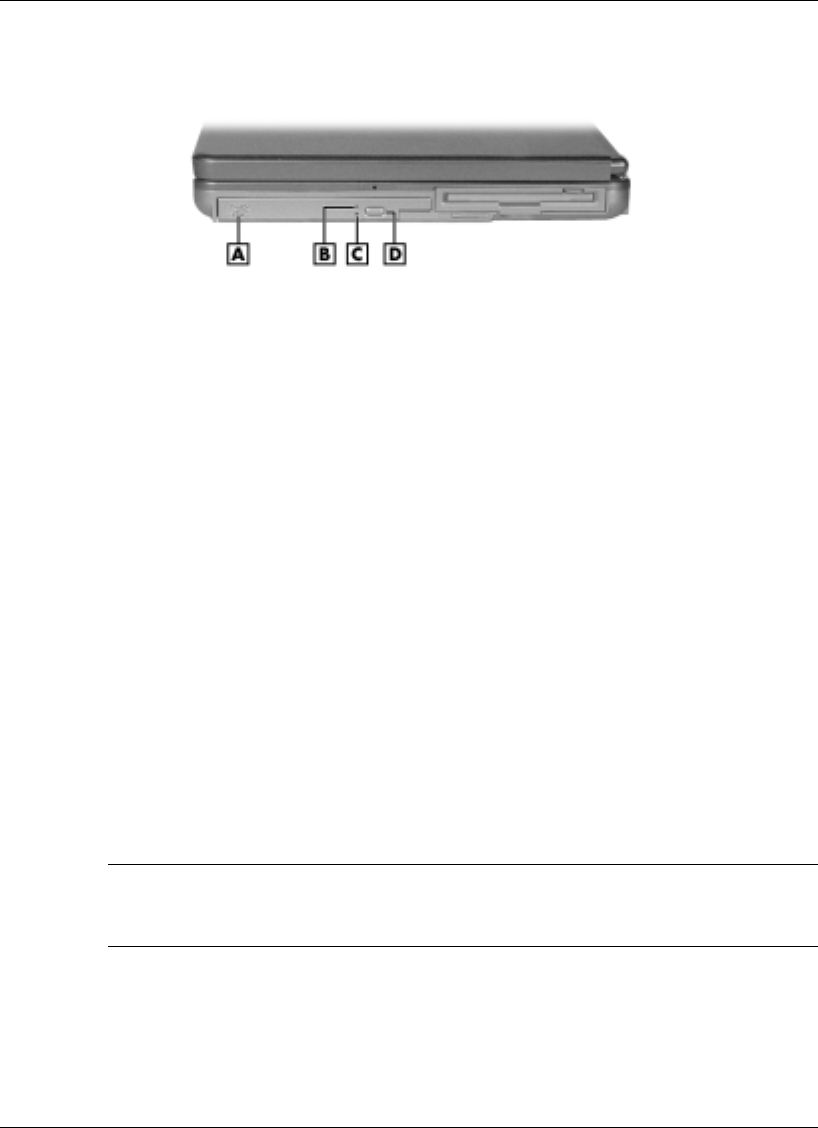
Using the System Drives and Bays 5-11
DVD-ROM drive features
A – DVD-ROM Drive C – Emergency Eject Hole
B – DVD-ROM Drive Status LED D – Disc Eject Button
Combination CD-RW and DVD-ROM Drive
Your system might come with a combination CD-RW and DVD-ROM drive. Use the
drive to load and start programs from a compact disc (CD) or to play your audio CDs,
write information to a CD, or play digital video discs (DVDs).
The CD-RW/DVD-ROM combination drive offers the following features (see the
following figure).
! Status LED — Lights during data read operations. Do not eject the disc or turn off
the NEC Versa notebook when the indicator is lit.
! Emergency Eject Hole —Allows you to manually remove a disc from the
CD-RW/DVD-ROM drive if the eject function is disabled by software or a power
failure.
To remove a disc, insert the end of a paper clip into the eject hole, and push in until
you hear a click. Manually open the drawer.
! Eject Button — Ejects the tray. Press this button when power is on to insert a disc
into or remove a disc from the drive.
Note CD-RW media must be formatted before you use it. Systems with CD-RW
drives ship with an NEC CD-RW Software CD. Install the software on your system from
this CD (see “NEC CD-RW CD” in Chapter 4.)
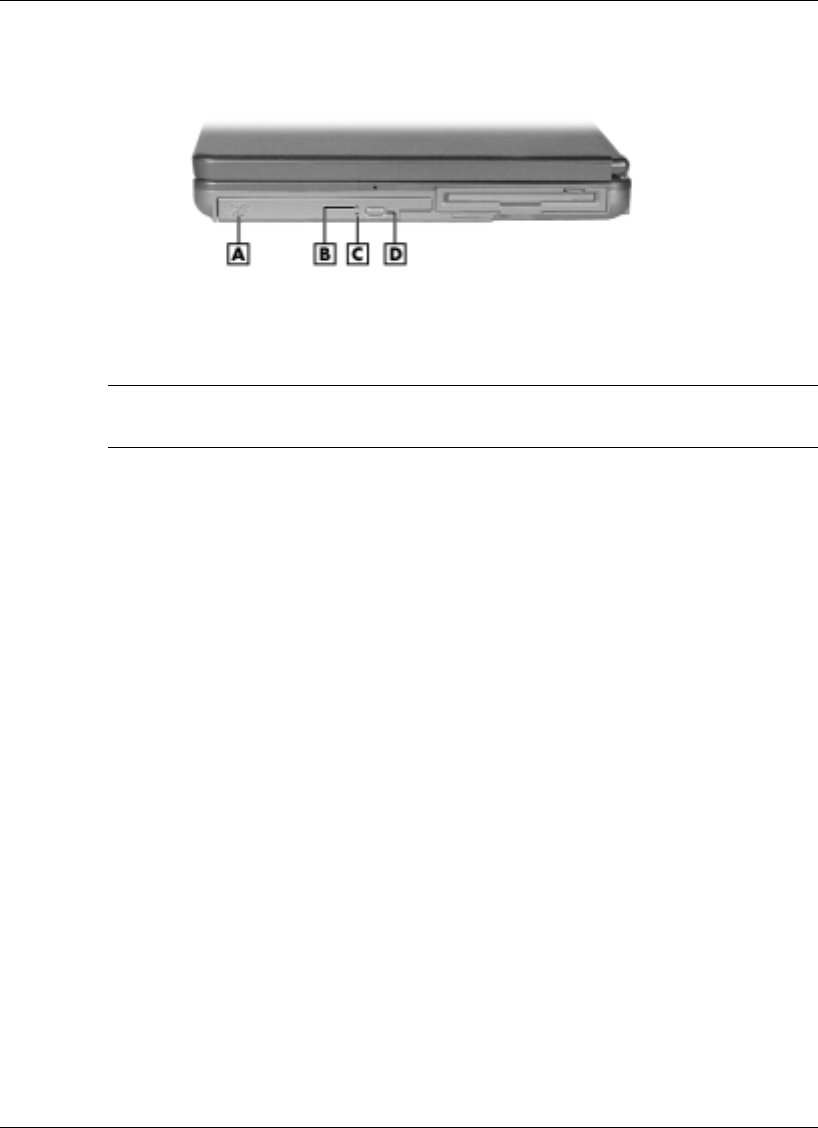
5-12 Using the System Drives and Bays
Combination CD-RW and DVD-ROM drive features
A – Combo CD-RW/DVD-ROM Drive C – Emergency Eject Hole
B – Combo Drive Status LED D – Disc Eject Button
Note Software and drivers for the combination CD-RW and DVD-ROM drive are
provided separately on a CD. Printed installation instructions are packaged with the CD.
Memory Modules
The notebook computer offers two 64-bit memory slots using 144-pin SO-DIMMs
(Small Outline Dual Inline Memory Modules). Each slot supports a 128-MB, 256-MB,
or 512-MB (when available) SDRAM module. The memory slot supports a single
SO-DIMM. The memory slots are located on the underside of your computer inside the
memory bay.
Follow these steps to upgrade the system memory.
1. Power off the system and disconnect any peripheral devices.
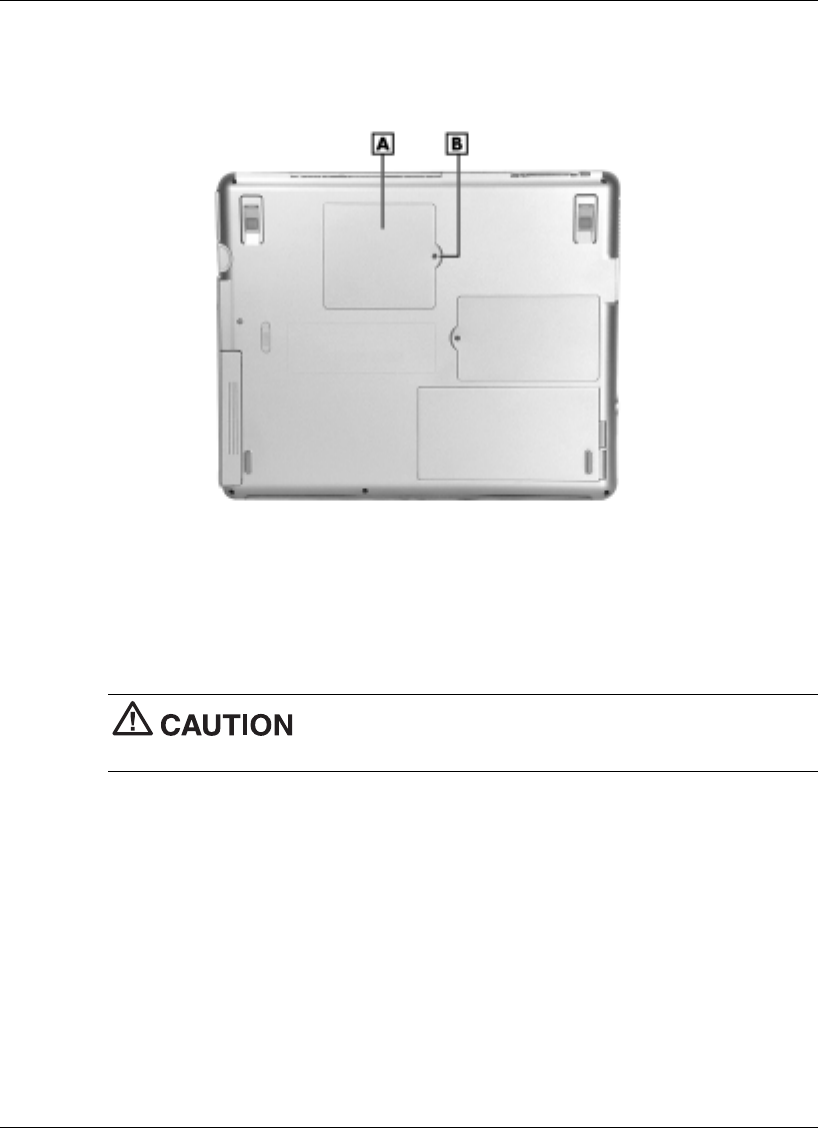
Using the System Drives and Bays 5-13
2. Turn the system over and locate the screw on the memory bay cover.
Memory bay cover and screw
A – Memory Bay Cover B – Screw
3. Remove the screw and lift off the memory bay cover.
4. If you need to remove a module for the upgrade, remove it as follows (see the
following figure).
Before handling any internal components, discharge static
electricity from yourself and your clothing by touching a nearby unpainted metal surface.
! Press the locking tabs away from the sides of the module until the module
pops up at an angle.
! Pull the memory module out of the slot along the angle.
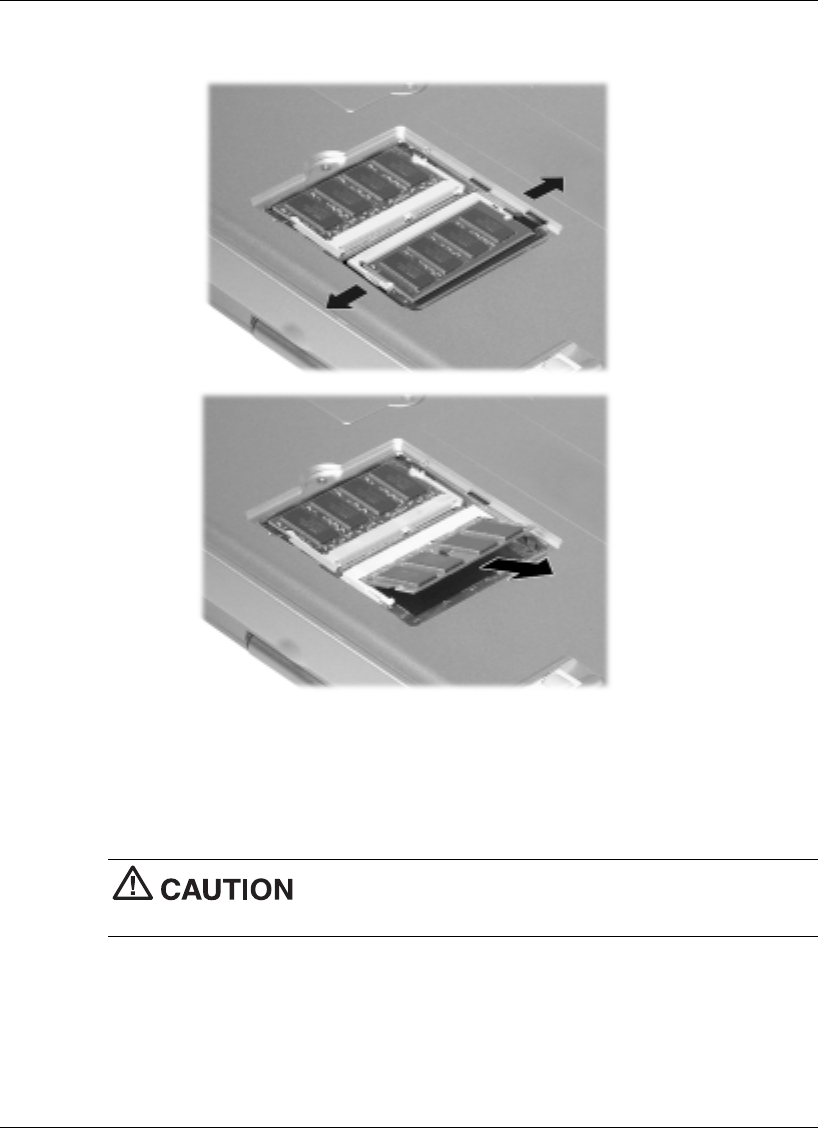
5-14 Using the System Drives and Bays
Removing the memory module
5. Locate the alignment notch on the upgrade module.
6. Locate the memory module slot.
7. Align the notch on the module with the notch in the slot connector and install the
module as follows (see the following figure):
Before handling any internal components, discharge static
electricity from yourself and your clothing by touching a nearby unpainted metal surface.
! Hold the memory module at a 60-degree angle and align its connector with the
slot in the system. Push the memory module into the slot.
! Press down on the edge of the memory module until the locking tabs on the
sides snap into place, securing the module.
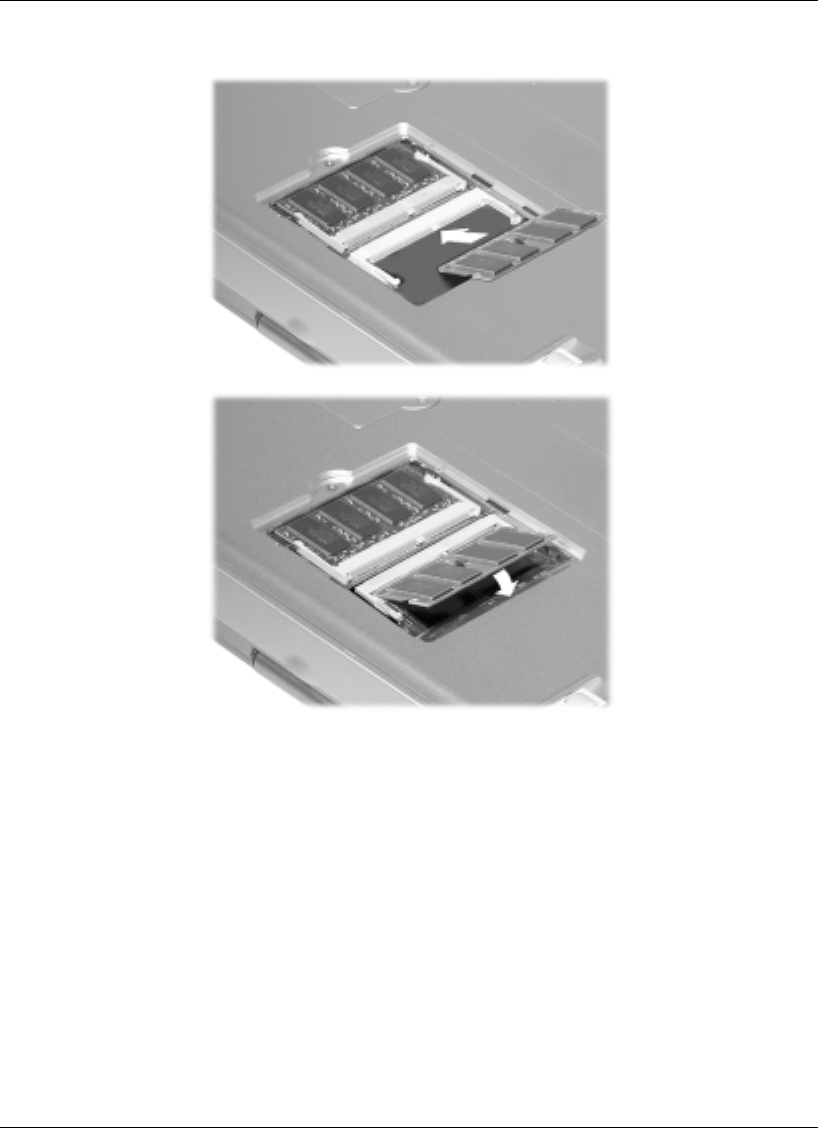
Using the System Drives and Bays 5-15
Installing the memory module
8. Reassemble the NEC Versa L320 components as follows.
! Replace the memory bay cover.
! Replace the screw.
! Turn the system over.
6
Communicating with Your NEC Versa
! MDC Modem
! Mini PCI LAN
! PC Cards
! Internet Connections
! IR Port
! Mini PCI Wireless LAN
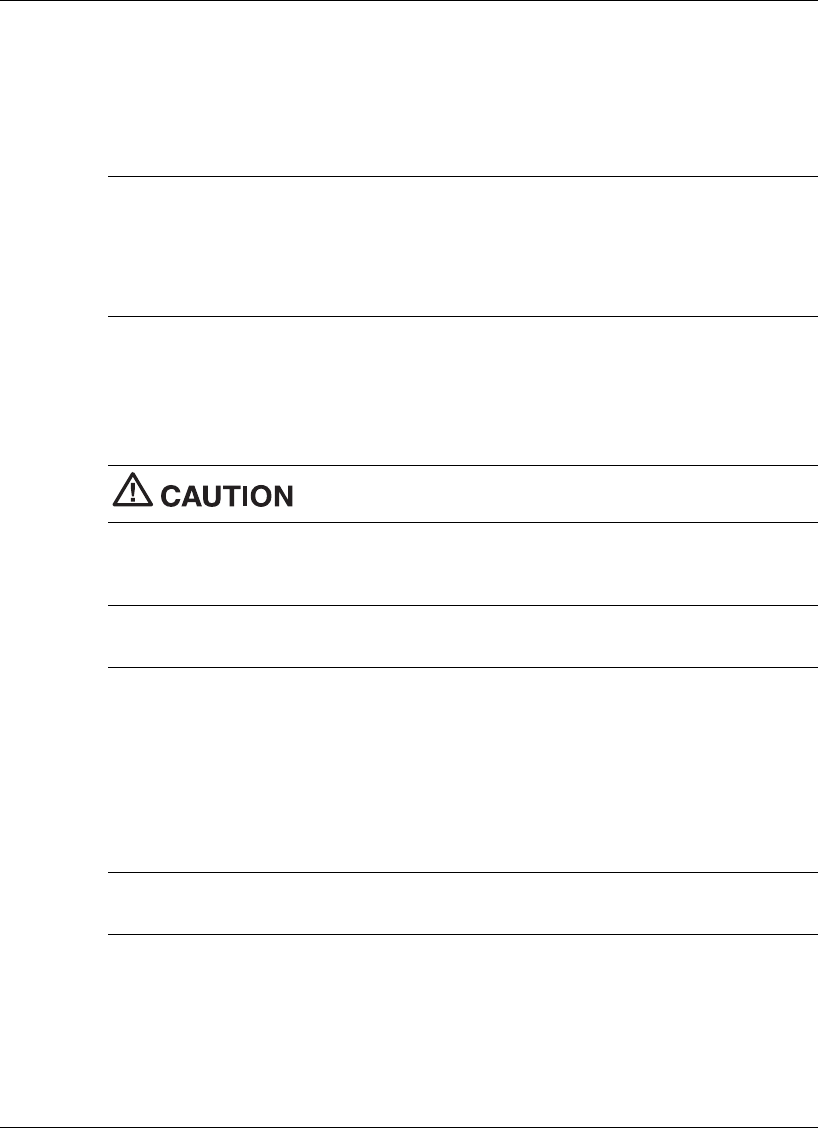
6-2 Communicating with Your NEC Versa
MDC Modem
Some models of the NEC Versa L320 come equipped with a 56K capable fax/data
modem that allows you to communicate with others via fax or e-mail, or to connect to
an online service or bulletin board.
Note Due to FCC regulations in effect at the time that this document was printed,
the 56K modem transmits at a maximum speed of 52K.
The speed of data transmission is dependent on the quality of telephone lines. Digitally
terminated lines improve the speed of data transmission. Contact your service provider
for more information.
Connecting the Modem
The fax/data modem provides one standard phone connector. NEC provides one analog
cable for your convenience.
Use only 26AWG phone line when connecting the modem.
Use the following steps to connect the analog phone cable to your modem.
Note When using a modem outside the U.S. and Canada, you might need an
international telephone adapter, available at most electronics supply stores.
1. Locate the analog phone cable that ships with the NEC Versa L320. Each end of
the cable has a RJ-11 connector that plugs into a standard wall outlet.
2. Connect one end of the cable into a standard telephone wall outlet.
3. Connect the other end of the cable into the computer’s modem port on the left side
of the system (see “Around the Left Side of the System” in Chapter 1).
Note Depending on your operational requirements, you may need to disable the
modem in order to enable the IR port for wireless data transfer.

Communicating with Your NEC Versa 6-3
Mini PCI LAN
Some NEC Versa L320 systems ship with Mini PCI LAN, a 10/100Base-TX interface
that allows connection of your system to a local area network and supports both Wake-
on-LAN and Network Boot functions.
To take advantage of the interface, simply connect an RJ-45 cable to the LAN port on
the left side of the system (see “Around the Left Side of the System” in Chapter 1).
PC Cards
PC Cards are all approximately the same size and vary only in thickness. All have a
standard 68-pin connector. Your NEC Versa supports the installation of the PC Cards
described next.
Type II Cards
Type II cards have a thickness of 5.0 millimeters (mm). Type II cards are often storage
or communications devices such as battery backed Static Random Access Memory
(SRAM), Read Only Memory (ROM), Flash Memory, LAN, and Small Computer
System Interface (SCSI). Typical Type II cards include input/output (I/O) features such
as modems and LANs.
Type II Extended Cards
Many PC Cards are Type II extended cards. The extended card has an additional
physical component that protrudes beyond the traditional card size. The extension can
be as large as 40 mm deep by 9.65 mm high. This extension provides room for
additional electronics as well as a location for external connectors.
Type III Cards
Type III cards are thicker (10.5 mm) than Type II cards and allow no extensions. Type
III card uses include advanced function I/O cards with additional features such as
wireless modems, multimode cards (cards with more than one function such as a
combined modem and LAN card), and small hard drive storage.

6-4 Communicating with Your NEC Versa
Communication Cards
You can use fax/modem and network PC Cards with your NEC Versa. Here are some
suggestions to help you get the best system performance.
Note If you are using this unit outside the United States or Canada, contact a local
NEC dealer for availability information.
! Network Cards — You can use a network card with your system to gain access to a
local area network (LAN).
You can insert a network card in either slot.
! Fax/Modem Cards — You can use a PC Card modem with your system to
communicate with others via fax, e-mail, or connect to an online service or bulletin
board.
You can insert a fax/modem card in either slot.
Note Outside the U.S. and Canada, you might need a modem and telephone
adapter approved for the local telephone system. Check with your local dealer for details
about purchasing this equipment.
Always insert the fax/modem card before using your fax/modem software application.
If you start the application before inserting the fax/modem card, the application
typically does not find the card.
Storage Cards
When you insert a memory or storage card in an NEC notebook computer, it appears as
a unique drive as long as the system has an available interrupt for the card.
Interface Cards
You can connect most standard Small Computer System Interface (SCSI) devices using
the optional NEC PC Card-SCSI card.
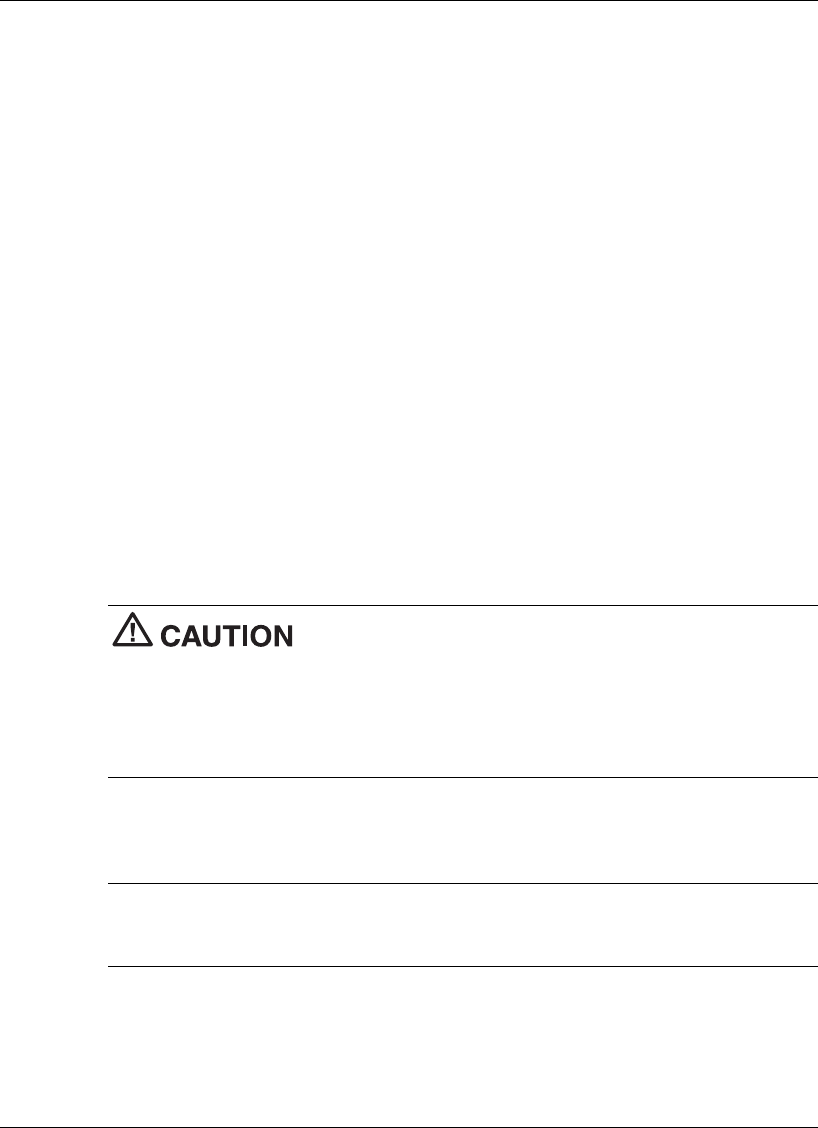
Communicating with Your NEC Versa 6-5
Other Cards
Many other kinds of PC Cards are available for notebook computers. They include the
following cards:
! Global Positioning System (GPS) — Enables the tracking of remote units (for
example, delivery trucks)
! Serial — Adds an extra serial communications port
! Multimedia — Combines animation and sound
! Audio — Enables the use of sound (for example, in voice mail).
PC Card Slots
Your NEC Versa L320 has two Cardbus slots for inserting two PC or Cardbus cards.
The slots support two Type II cards or one Type III PC Card.
Using the system’s PC Card slots, you can add optional PC Cards and connect external
devices to your NEC Versa L320. These devices include devices, such as modems,
LAN cards, and storage cards.
Inserting a PC Card
Follow these steps to insert a PC Card in your system.
Some PC Cards require additional system resources. Before
inserting a PC Card you might need to disable either the IR port, USB port, or internal
modem. Check the Windows device manager to ensure that one of these devices is
disabled before inserting a PC Card.
For information about enabling and disabling devices on your NEC Versa L320, see
“Enabling and Disabling Devices,” later in this chapter.
1. Align the card so that the 68-pin connector points towards the slot and the arrow on
the PC Card faces up (see the following figure).
Note Use the PC Card software preinstalled on your system to check PC Card slot
availability. For example, look for the PC Card icon in the Windows Control panel. It
shows which slot contains a PC Card and which is empty.
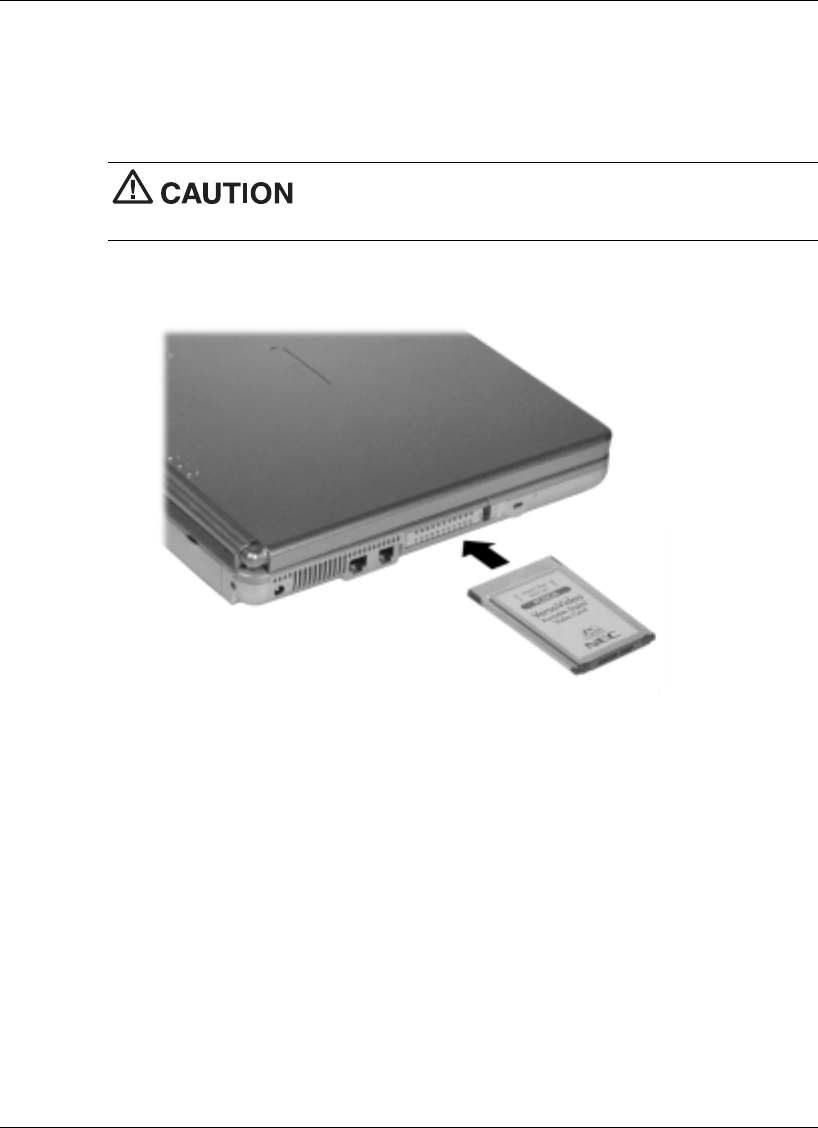
6-6 Communicating with Your NEC Versa
2. Slide the card into either slot (Type III cards can only be inserted in the bottom
slot).
A low tone followed by a high tone lets you know that the card is fully inserted and
recognized. (If you turn off the sound, no sound is emitted.)
Other two-tone sequences such as high, then low tones
indicate that the card is inserted, but the card type is unknown.
Inserting a PC Card
Removing a Card
Follow these steps to remove a PC Card in Windows 98.
1. Double click My Computer, double click Control Panel, and double click the PC
Card icon or simply double click the PC Card icon from the taskbar.
2. Select the PC Card to remove, and select Stop.
The Windows operating system alerts you if any applications are still using the
card. If all applications using the card are closed, services for that card are shut
down. You receive a message saying that it is safe to remove the card.
3. Press the button on the side of the PC Card in the slot twice.

Communicating with Your NEC Versa 6-7
Internet Connections
Your NEC Versa L320 system is equipped with the Windows operating system to
provide a fully-integrated Internet experience. Use the Internet Connection Wizard on
your desktop to configure your system for e-mail and Internet access. Sign up for a new
account or configure your system to use an existing account.
Before using the Internet Connection wizard, to transfer an existing account for e-mail
and Internet access, you need an Internet service provider (ISP) account and some or all
of the following configuration information:
! the dial-up telephone number
! TCP/IP settings
! port settings
! a user name/logon and password
! your e-mail address
! the name of a POP3, IMAP, or HTTP server (for incoming mail)
! the name of an SMTP server (for outgoing mail).
Internet Connection Wizard in Windows 98/2000
Access the Internet Connection Wizard in Windows 98/2000 through its desktop icon.
The Windows 98/2000 Internet Connection Wizard offers the following choices:
! Sign-up for a new Internet account. Take advantage of the Microsoft Internet
Referral Service.
! Transfer an existing Internet account.
! Manually configure an Internet account or connect through a local area network
(LAN).
Launch the connection wizard and follow the on-screen prompts to configure your
system for Internet access.
Accessing the Internet
Your NEC Versa L320 system is equipped with an Internet shortcut button, located just
above the keyboard. The first time that you press the Internet shortcut button, the
Internet Connection Wizard launches, allowing you to configure your system for
Internet access.

6-8 Communicating with Your NEC Versa
Once your Internet connection is configured, pressing the Internet shortcut button
launches your associated dial-up network connection, allowing you to enter your logon
name and password. In addition, Microsoft Internet Explorer launches, providing quick
access to your favorite Internet sites.
Sending and Receiving E-mail
Your NEC Versa L320 system is equipped with an E-mail shortcut button, located just
above the keyboard. The first time that you press the E-mail shortcut button, the
Internet Connection Wizard launches, allowing you to configure your system for e-mail
access. Once your Internet connection is configured, pressing the E-mail shortcut
button launches your associated dial-up network connection, allowing you to enter your
logon name and password. In addition, Outlook Express launches, providing quick
access to your e-mail functions.
Modifying the Internet and E-mail Shortcut Buttons
The Internet and E-mail shortcut buttons are configured (default setting) to launch your
Internet browser and e-mail applications, respectively. You can modify the default
application settings with the One-Touch Start Button Settings utility which comes on
the Application and Driver CD. See “One-Touch Start Button Settings Utility” in
Chapter 4 for information about running this utility.
IR Port
The IR port on the front of your system lets your NEC Versa L320 communicate with
other devices that also use infrared technology. To locate the IR port, see “Front
Features” in Chapter 1.
The IR port is Infrared Data Association (IrDA) compatible. You can easily transfer
files between your NEC Versa L320 and an IR-equipped desktop, or print to an
IR-equipped printer without using cables.
IR transfer speed ranges from 2.4 Kbit/sec to 4.0 Mbit/sec. You can limit the IR
transfer speed through the Infrared icon in the Windows control panel. Double click
the icon and select the options to access the speed parameter.
Your NEC Versa transfers data at the speed compatible with the receiving device.
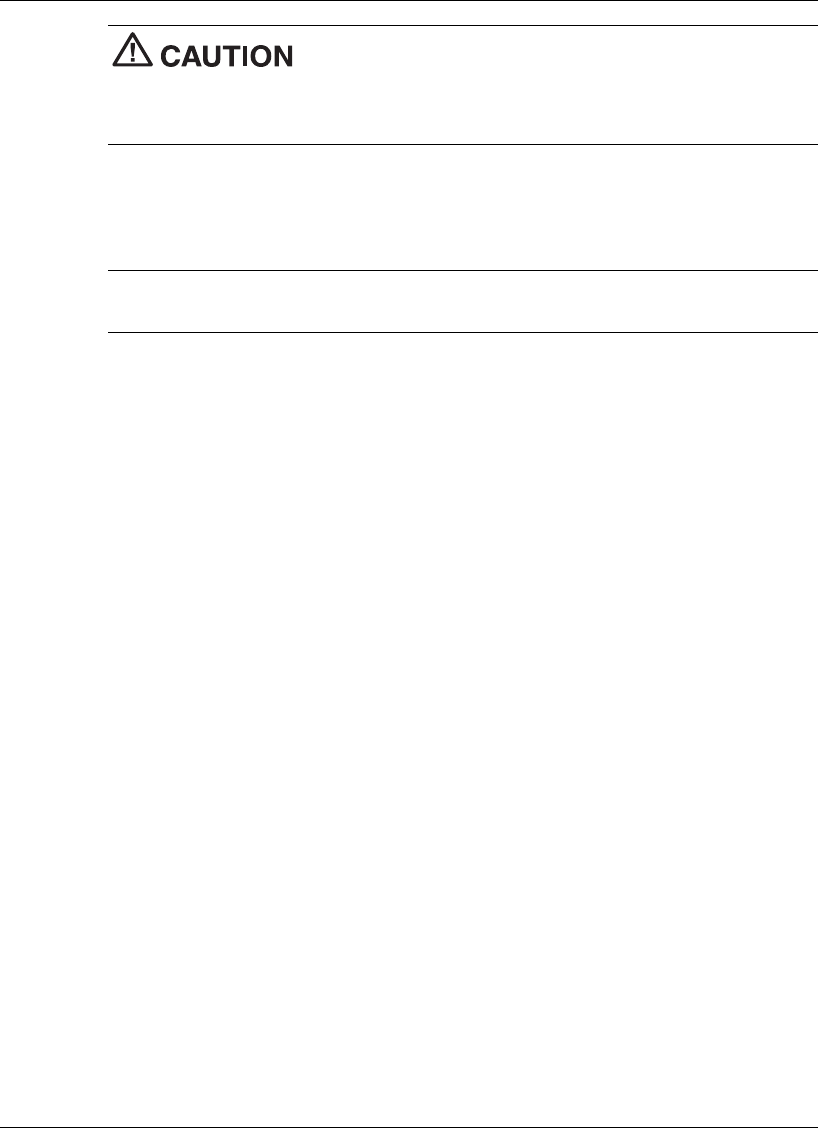
Communicating with Your NEC Versa 6-9
Your NEC Versa ships with the IR port disabled. Before using
the IR port for the first time, you must enable the device. For Windows 98 operating
systems, also enable infrared communications in the Windows Control Panel. See the
following sections to enable the IR port and infrafed communications.
Enabling the IR Port
Follow these steps to enable the IR port.
Note Once you enable the IR port in the BIOS Setup utility, the transfer speed
defaults to the Fast IR (FIR) 4.0-Mbit/sec speed.
1. Access the BIOS Setup utility at power-on. Just press F2 when the prompt, “Press
<F2> to enter Setup,” appears.
The BIOS Setup main menu appears.
2. Using the arrow keys, select the Advanced menu and I/O Device Configuration
parameter.
3. Press Enter to select the I/O Device Configuration menu.
4. Using the arrow keys, select “Infrared port.” Press Enter and select “Auto.”
5. Press Enter to select the change.
6. Select the Exit menu. Select “Exit Saving Changes.” Press Enter. Select “Yes” to
confirm changes and to exit the utility.
Enabling Infrared Communications
If you have a system running the Windows 98 SE operating system, enable infrared
communications as follows.
1. From the Windows Start menu, select Settings and Control Panel.
2. Double click the Infrared icon.
3. Select the Options tab.
4. Check the box to “Enable infrared communication.”
5. Click Apply and clickOK.

6-10 Communicating with Your NEC Versa
Using the IR Port
Follow these guidelines when using the IR port to communicate with another infrared
device.
! Position the NEC Versa L320 no more than three feet away from the IR peripheral
device you are using.
! Make sure that there is no greater than a 30º angle between the computer and the
device.
Note If you have a hardware conflict using the IR port to communicate with an
external device when a PC Card is installed, use the Windows device manager to
disable either the USB port or the internal modem (available on some models). Ensure
that the IR port has been enabled through the Setup utility. If you are running the
Windows 98 operating system, be sure that infrared communications is enabled.
In the Windows 2000 environment, the default setting for infrared communications is
FIR (Fast Infrared). If you need to change an SIR (Serial Infrared) setting to FIR,
follow these steps.
1. From the Windows Start menu, select Settings and Control Panel.
2. Double click the System icon, select the hardware tab, and click the Device
Manager button.
3. Click Infrared devices and double click Built-in Infrared Devices.
4. Select the Driver tab and click the Update Driver button.
5. Click Next when the Update Device Driver Wizard appears.
6. Select ‘Display a list of the known drivers for this device so that I can choose a
specific driver,’ and click Next.
7. Select ‘Show all hardware of this device class.’
8. Use the scroll bar in the Manufacturer’s window to view and select ‘SMC.’
9. Select ‘SMC IrCC-Fast Infrared Port under the Infrared Devices window and click
Next.
10. Click Yes when the Update Driver warning appears.
11. Click Next to initiate the update.
12. Click Finish, then click to close the System window.
13. Click Yes when prompted to restart your system.

Communicating with Your NEC Versa 6-11
Mini PCI Wireless LAN
Some NEC Versa L320 notebook computers come with built-in wireless LAN
capabilities featuring the Wi-Fi™ (wireless fidelity) IEEE 802.11b High Rate (HR)
standard for business users. Wireless LAN eliminates the need for connecting cables
between your computer and your local area network, facilitating mobility, minimizing
downtime, and improving your productivity.
The Wi-Fi compliant radio technology provides high-speed (11 Mbps) wireless
networking with the performance capabilities of a wired 10BaseT LAN connection.
NEC Versa L320 wireless LAN configurations come with Client Manager and driver
software installed and basic parameters set.
See the following sections for information about using the wireless LAN solution in the
NEC Versa L320 notebook computer.
Enabling Wireless LAN in BIOS Setup
Before you can use the built-in wireless LAN, you must enable wireless LAN in the
BIOS Setup utility. Use the following steps to enable wireless LAN:
1. Power on the NEC Versa L320 system. Press F2 at the BIOS Setup prompt. The
Main Setup menu appears.
2. Using the arrow keys, select the Advanced menu and the Wireless LAN menu
item.
3. Press Enter to bring up the Wireless LAN settings.
4. Using the arrow keys, select “Enabled.” Press Enter to select the change.
5. Select the Exit menu. Select “Exit Saving Changes.” Press Enter. Select “Yes” to
confirm changes and to exit the utility.
Checking Your Wireless Connection
Use the Client Manager software on your system to:
! verify the quality of your wireless connection to the network
! view/modify the wireless LAN configuration settings.
The Client Manager software starts automatically when you power on the NEC Versa
L320 system. The Client Manager icon (stepped vertical bars) in the Windows system
tray indicates that your system is running the Client Manager program.

6-12 Communicating with Your NEC Versa
The default profile scans for any access points in the area. The Client Manager icon
indicates the signal strength from your system to the access point. An icon with green
showing in all bars indicates an excellent radio connection.
If the Client Manager icon shows clear with a red box and a black jagged horizontal
line, you have no radio connection. Check that you have enabled the Wireless LAN
parameter in BIOS Setup (see the previous section).This icon status can also indicate
that you are out of range from your network.
The radio signal depends upon:
! an access point in the area
! default profile.
See the following table for a summary of Client Manager status.
Client Manager Status
Icon Color Radio Signal
Green Excellent radio connection.
Yellow Marginal radio connection. The radio connection is
weak. Move closer to an access point.
Red Poor radio connection. The radio signal is very weak.
Save your files and move closer to an access point.
Red with jagged
horizontal line
No radio connection. Looking for initial connection or
you have moved out of range of the network. Need to
set up a profile or move closer to an access point.
Blank Peer-to-Peer network connection.
Note The default profile configuration might require modification for your network.
See your system administrator for appropriate settings.
Viewing/Changing Configuration Settings
Use the Client Manager software to view or change your profile configuration. See
your system administrator for help in setting the appropriate profile for your network.
For Client Manager options:
! Left-click the Client Manager icon to bring up a detailed status overview.
! Right-click the Client Manager icon to display a menu with more options.

Communicating with Your NEC Versa 6-13
The Client Manager main window displays the status of your active configuration
profile and the quality of your connection. Menu items are available to add/edit your
profile and to select advanced Client Manager options.
From the main Client Manager window, select Actions in the menu bar. Select the
Add/Edit Configuration Profile option to activate a wireless profile from the pull-down
menu or to add, edit, or delete a user-defined wireless profile.
Client Manager provides options in the configuration process to:
! describe your profile (for example, my office)
! identify your network (ID name of access point)
! set security/encryption
! set power management (default is power consumption high performance)
! set TCP/IP behavior (requires an IP address from your system administrator).

7
Traveling Tips
! Preparing for Travel
! Packing for Travel
! Using Power Connections
! Getting Through Customs
! Connecting to the Internet

7-2 Traveling Tips
Preparing for Travel
The NEC Versa computer makes a natural traveling companion. With a little
preparation you can use the computer practically anywhere you go, to prepare your
business documents, confirm your travel plans, surf the Internet, or simply stay in touch
with those back home!
Here is what you should do before you leave home:
Note Speed the trip through airport security by carrying a charged system.
Inspectors may want to see the screen display a message. The boot message is usually
sufficient.
If your system is fully charged, the inspection only takes a minute or so. Otherwise, be
prepared to attach the AC adapter and power cable. And if you don’t have these, the
inspection might include a disassembly of the system.
! Back up your NEC Versa’s hard disk.
! Insert a fully charged battery to make sure your system is ready to quickly boot up
at the airport security check.
! Fully charge all your batteries.
! Tape your business card to your NEC Versa, AC adapter, and batteries.
! If you run your system with battery power, maximize battery life by using
power-saving features whenever possible.
! Take along any application or data files that you might need on diskettes or CDs.
! Check that you have everything you need before you leave on a trip.
Packing for Travel
The following are what you should take with you when you travel with your
NEC Versa.
! Extra fully charged batteries
! Single-outlet surge protector
! Appropriate AC plug adapter for international voltage requirements
! Extra phone cord to access hard to reach wall jacks
! Copy of proof of purchase for your computer and other equipment or customs
registration form for customs check

Traveling Tips 7-3
! Customer support phone numbers for your software (domestic and international)
! NEC Versa Quick Reference card
! AC extension cord.
Using Power Connections
With the right accessories, you can run your NEC Versa almost anywhere! Your
system self-adjusts to various power sources. The United States, Canada, and most of
Central and South America use 120-volt alternating current (AC). Most other countries
of the world use 240-volt AC. The NEC Versa adapts to voltages ranging from 100 to
240 volts, 50 or 60-Hz.
There are a few countries with areas that use direct current (DC) as their main power
source. You need a DC-to-AC converter in particular areas of Argentina, Brazil, India,
Madeira, and South Africa.
To use your system overseas, you need an adapter plug. There are several different
plugs available worldwide. You can buy these at an electronics supply store.
Getting Through Customs
With so many countries in the world, you can be sure that there are a variety of customs
regulations. Plan wisely to get your NEC Versa notebook computer through customs by
carrying the appropriate documentation to assure the customs agent that your system is
not a recent purchase.
Travelers are often asked, when returning to their home country, whether or not they
purchased the computer while outside of the country. Sometimes, the proof of purchase
such as a bill of sale, insurance policy, or purchase receipt is sufficient. Taking along
the purchase receipt for your notebook computer may sound practical, but may not
always suffice, particularly when the purchaser of the computer is your company and
the original receipt is not available to you.
Another alternative to a proof of purchase document is a Certificate of Registration, a
document that is issued when you register your notebook computer with the Customs
Service prior to departure. The certificate of registration contains a brief description of
your computer and lists appropriate serial numbers for identification. The document is
available from the customs web site at http://www.customs.ustreas.gov/.
To avoid hassle when moving your system through customs, you may want to obtain a
certificate of registration and carry it whenever you travel out of the country with your
NEC Versa notebook computer.

7-4 Traveling Tips
Connecting to the Internet
Whether you are on a business trip or vacation, connecting to the Internet while you
travel can be expensive and frustrating unless you are prepared. Here are some tips on
how to avoid frustration and expense while on the road.
Connecting Using a Modem
If you have access to a standard telephone jack while you are traveling, you can
probably use your modem for dial-up access to your favorite sites. Follow these
guidelines for connecting and configuring your system.
1. Before leaving home, check with your Internet Service Provider to see if it has:
! A local access number at your point of destination.
! A toll-free number that can also save you money.
! In the absence of a local ISP access number or toll-free number, charging the
call to your home phone can be less expensive than charging the call to your
hotel room.
2. Prepare your system for phone line access in another country.
! Line access outside of a hotel may require the addition of a “9” preceding the
phone number string.
! To circumvent unusual dial tone sounds sometimes encountered in hotels, you
may have to modify a system configuration setting to “ignore the dial tone.”
3. Always check the phone line to determine whether or not it is digital vs. analog.
NEVER use your modem with a digital phone line. Doing so can destroy your
modem!
Connecting Using a LAN
Many hotels and convention centers now offer direct Internet access for a nominal fee.
If your hotel provides this service, follow these guidelines for connecting and
configuring your system.
! Many hotels can provide a LAN cable by prearrangement, so you can travel with a
minimum of accessories.
! Plug the LAN cable into your system and the LAN connector in the room or hall
where you want to access the Internet.
! After connecting the LAN cable, connect your system to an AC power outlet (if
desired) and power on your system.

Traveling Tips 7-5
! Try launching your browser (Microsoft Internet Explorer, or Netscape
Communicator, for example):
— If your TCP/IP network settings are already configured to “Use DHCP for
WINS Resolution” you should be able to access the Internet.
— If your TCP/IP network settings are not set to use DHCP, a help screen may
appear, or you may be directed to call the LAN provider for assistance
configuring your system.
Follow the instructions that are provided to you completely, so your settings
work effectively with the provider’s system.
! If you have problems, the hotel or convention center may be able to direct you to a
support technician.
8
Using External Devices
! Keyboard/Mouse
! USB Devices
! Serial Devices
! NEC Cable PortBar
! Monitor
! S-Video Supported Devices
! IEEE 1394 Devices
! Parallel Devices
! Audio Options
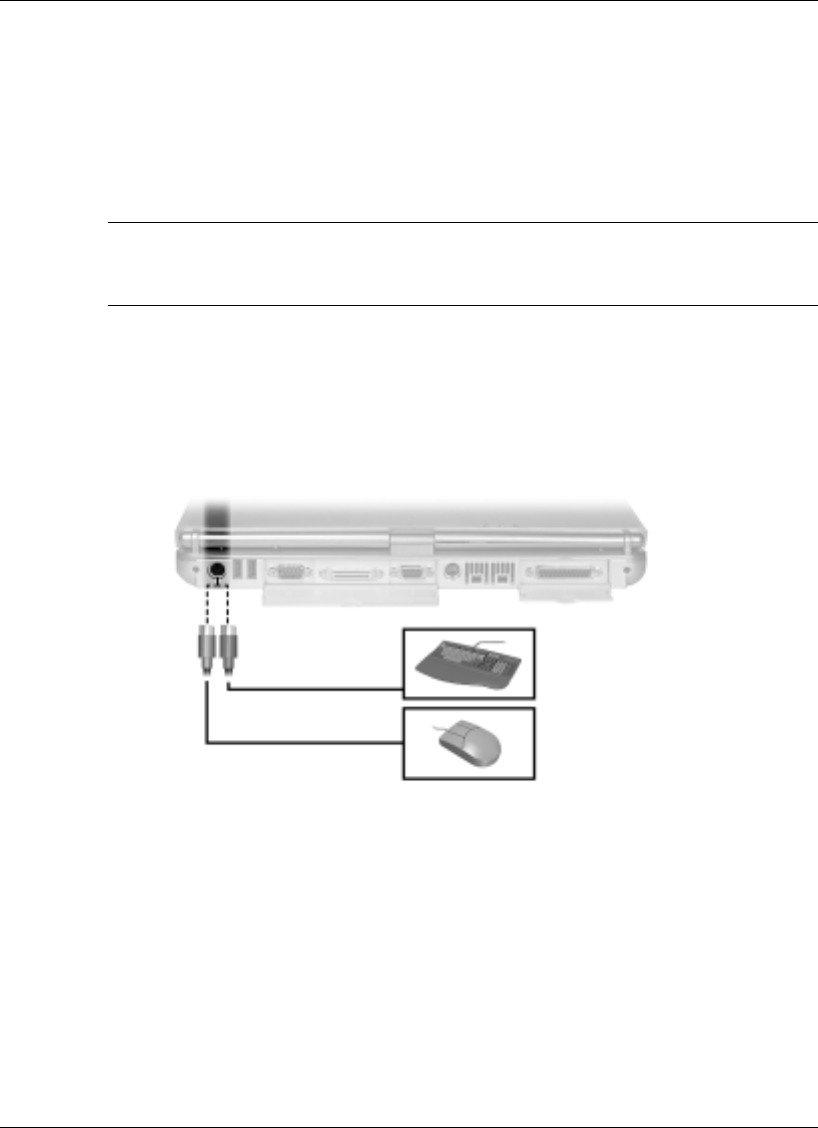
8-2 Using External Devices
Keyboard/Mouse
You can add a full-size PS/2-style keyboard or PS/2-style mouse to your NEC Versa
using the Plug and Play feature. The PS/2-style keyboard and the PS/2-style mouse are
warm insertable, allowing you to connect the devices while the NEC Versa is powered
on. You can continue to use the system keyboard and VersaGlide touchpad while an
external keyboard or mouse is connected.
Note For information about disabling the VersaGlide while an external mouse is
connected, see “Advanced Menu” in Chapter 3. The PS/2 Mouse parameter in the
Advanced menu lets you enable or disable the VersaGlide touchpad.
To connect an external keyboard or mouse simply put the system into a suspended
state, connect the device to the keyboard/mouse port, then resume the system when the
connection is secure. You are now ready to use your external keyboard or mouse.
Connecting an external keyboard/mouse
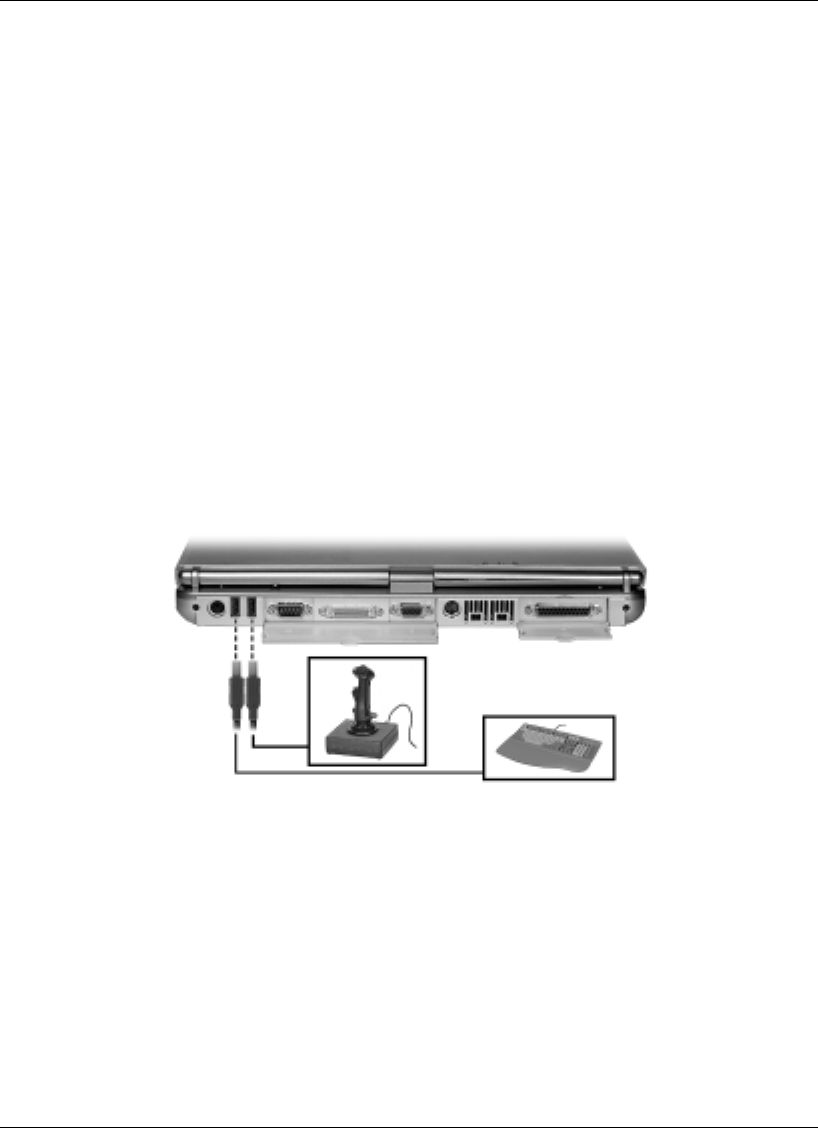
Using External Devices 8-3
USB Device
Your NEC Versa L320 system is equipped with two USB ports that increase your
connectivity choices. The USB ports on the back of your system each allow you to
connect up to 127 USB equipped peripheral devices to your NEC Versa notebook
computer. These peripherals may include a digital camera, scanner, printer, CD-ROM
drive, modem, mouse, keyboard, telephone, or game device.
USB devices called USB hubs can serve as connection ports for other USB peripherals.
Only one device needs to be plugged into your NEC Versa. Additional peripherals can
be connected in a daisy chain configuration where one device is connected to another in
a series. Up to 127 devices can be connected together in this way.
Connect an external USB device to your system as follows.
1. Locate the two USB ports on the back of your system.
2. Plug the USB device into one of the two USB ports. Another USB device can be
plugged into the other port.
Connecting a USB device
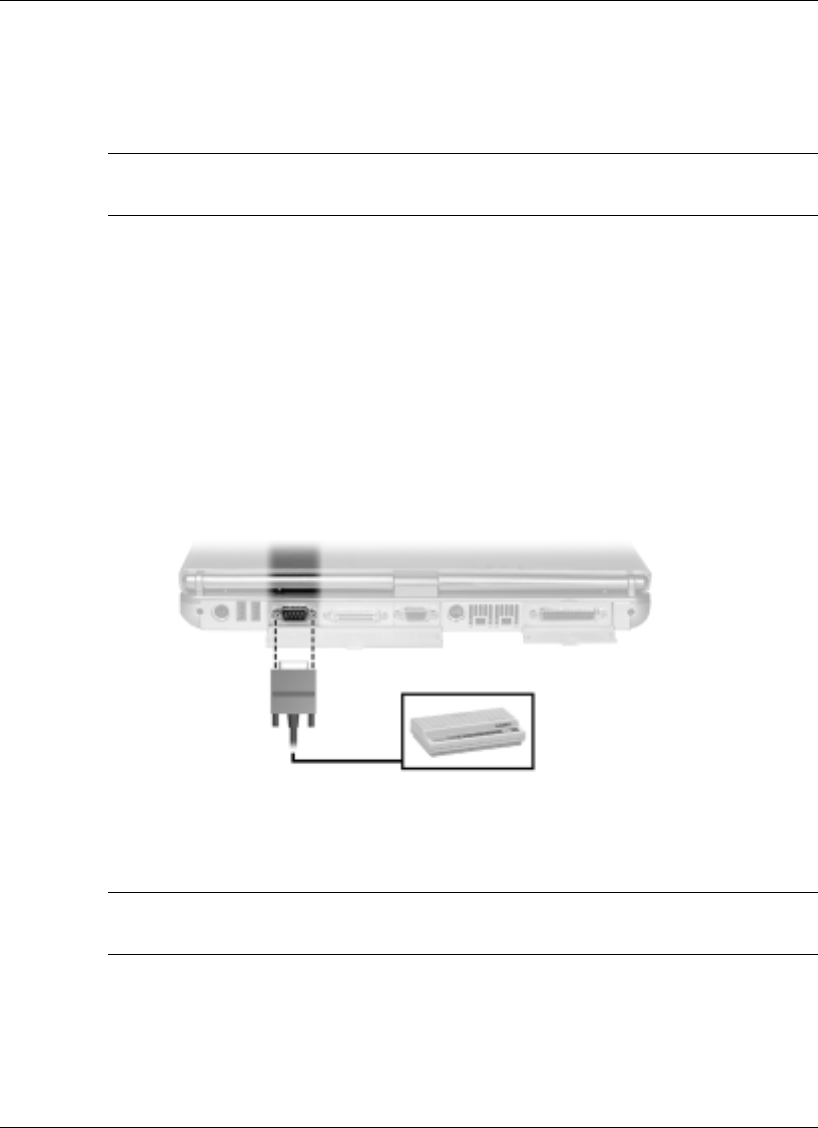
8-4 Using External Devices
Serial Devices
To install a serial device such as a printer or an external modem, you need a cable with
a female 9-pin connector.
Note When you connect a printer or modem, be sure to install the appropriate driver
through the Windows Control Panel.
Follow these steps to connect a serial device to your NEC Versa.
1. Check that power to both the NEC Versa and the device is off.
2. Align and connect the 9-pin connector with the serial port on the system. Secure
the connection with the screws provided.
3. Align and connect the other end of the cable to the appropriate port on the device.
Secure the connections with the screws provided.
Connecting a serial device
4. Connect the power cable to the device and a properly grounded wall outlet.
5. Turn on power to the system and the device.
Note Make sure your device is online before trying to print. See the device-specific
guide for instructions.
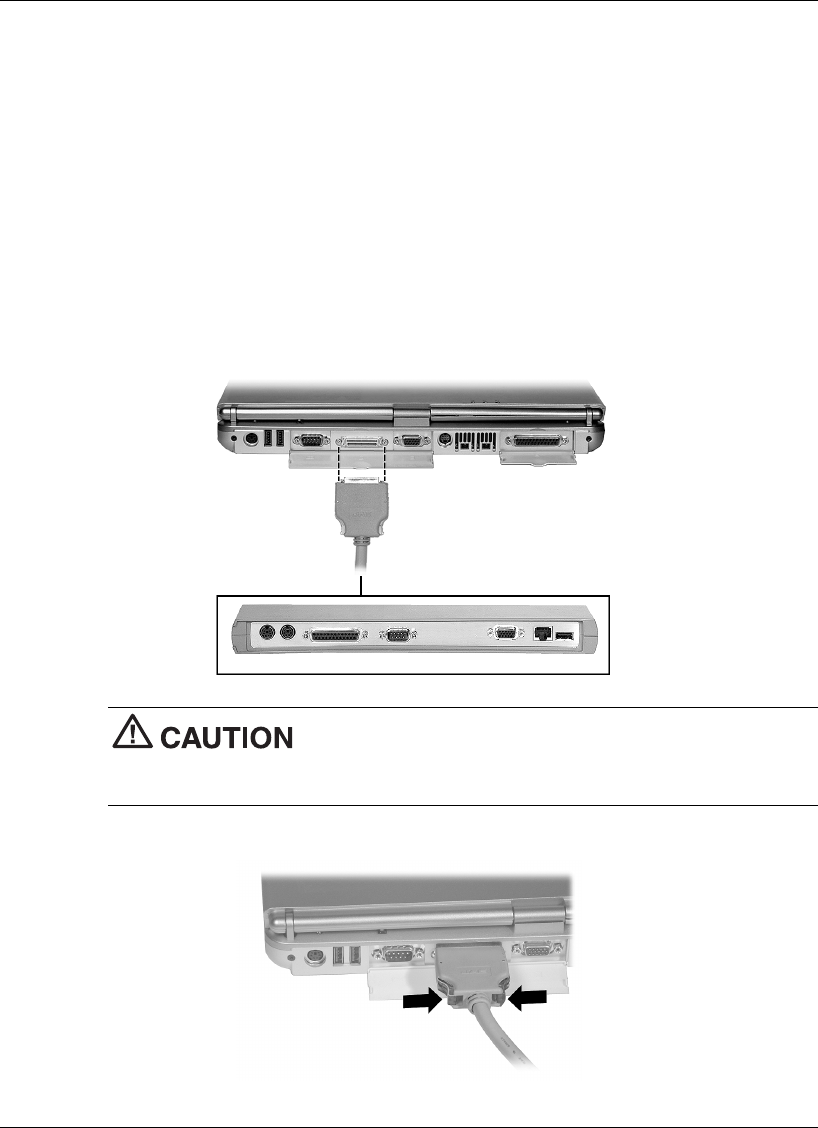
Using External Devices 8-5
NEC Cable PortBar
Use the following steps to connect the NEC Versa L320 to the optional NEC Cable
PortBar.
1. Disconnect the devices from the back of the NEC Versa that you want to connect
to the PortBar.
2. Align the PortBar connector with the port on the back of the system.
3. Squeeze the sides of the PortBar connector together. Insert the connector in the
port on the back of the system.
4. Connect the devices to the PortBar (see Chapter 1 for port identification.)
Connecting the PortBar
Press the releases on the sides of the PortBar connector
together while pulling the connector out. The cable connector and the connector on the
system can be damaged if the releases are not pressed.
Disconnecting the PortBar
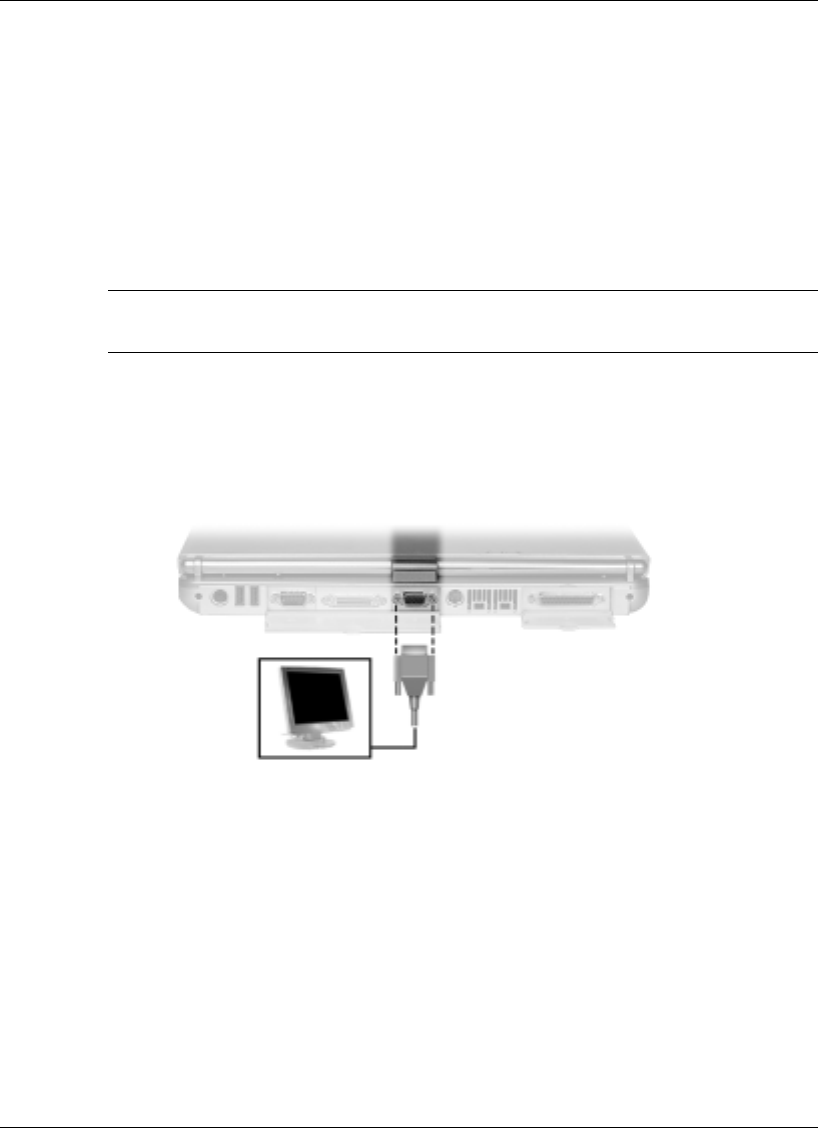
8-6 Using External Devices
Monitor
You can add a standard external monitor to your NEC Versa L320. You need a display
signal cable (usually provided with the monitor). One end of the cable must have a
15-pin connector for the system.
Follow these steps to connect an external monitor to your NEC Versa L320.
1. Check that the NEC Versa L320 is powered off and the monitor Power switch is
turned off.
Note The NEC Versa L320 must be powered off or suspended while the monitor is
being connected.
2. Attach the 15-pin cable connector to the monitor port on the system. Secure the
cable connection with the cable connector screws.
Connecting a monitor
3. Connect the monitor power cable and plug it into a properly grounded wall outlet.
4. Follow any setup instructions in the monitor user’s guide.
5. Turn on power to the system and device.
6. Press Fn-F3 to toggle through the video modes.
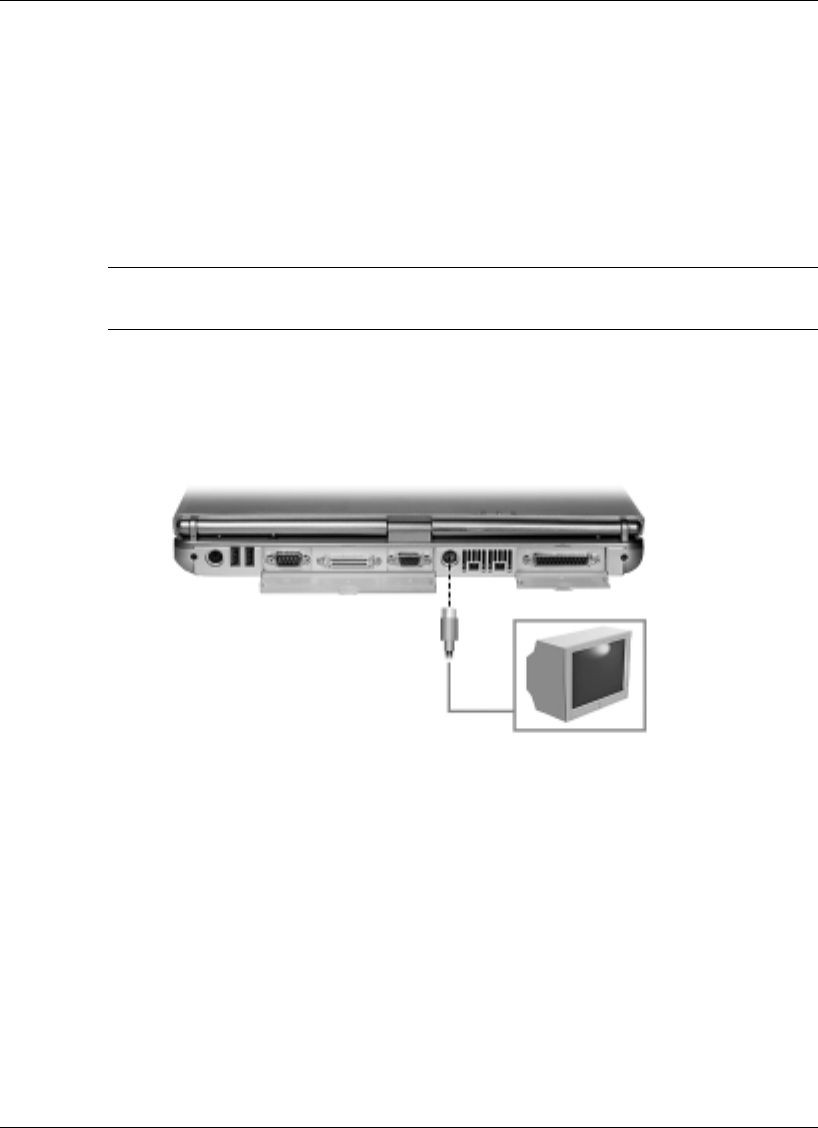
Using External Devices 8-7
S-Video Supported Device
You can add an S-Video supported device such as a camcorder, VCR, or game machine
to the S-Video connector on the back of your NEC Versa L320 notebook computer.
Follow these steps to connect an S-Video supported device to your NEC Versa L320.
1. Check that the NEC Versa L320 is turned off and the device power switch is
turned off.
Note The NEC Versa L320 must be powered off or suspended while the S-Video
device is being connected.
2. Attach the S-Video cable to the S-Video connector on the back of the system.
Connecting an S-Video supported device
3. Connect the S-Video supported device to an AC power source if necessary.
4. Follow any setup instructions in the device user’s guide.
5. Turn on power to the system and device.
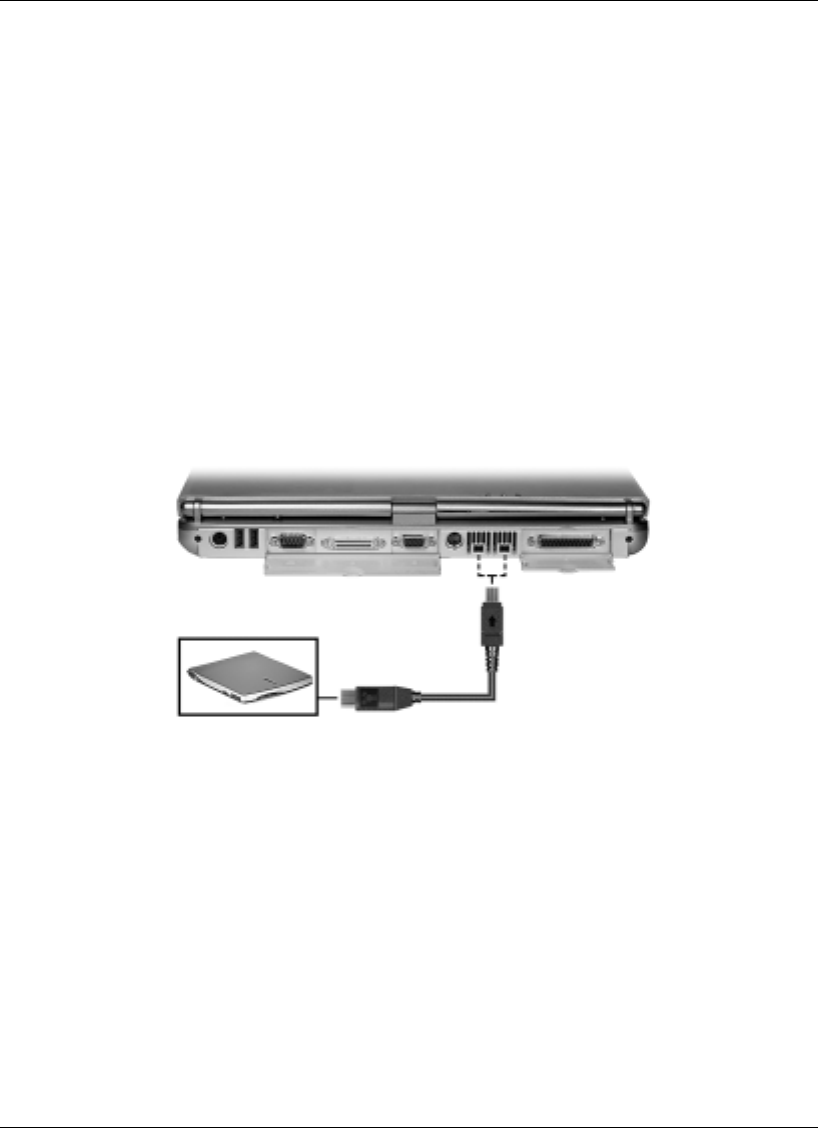
8-8 Using External Devices
IEEE 1394 Devices
Your NEC Versa L320 system is equipped with two IEEE 1394 ports that increase your
connectivity choices. The IEEE 1394 ports on the back of your system each allow you
to daisy chain up to 63 IEEE 1394 devices to your system. IEEE 1394 devices support
Plug and Play connectivity for transfer rates of up to 400 Mbps. These peripherals may
include a digital camera, scanner, printer, or other device.
Connect IEEE 1394 devices to your system as follows.
1. If you are running Windows 98 SE or Windows 2000, install the drivers for your
device.
2. Locate the IEEE 1394 ports on the back of your system.
3. Plug the IEEE 1394 device into either IEEE 1394 port.
Connecting an IEEE 1394 device
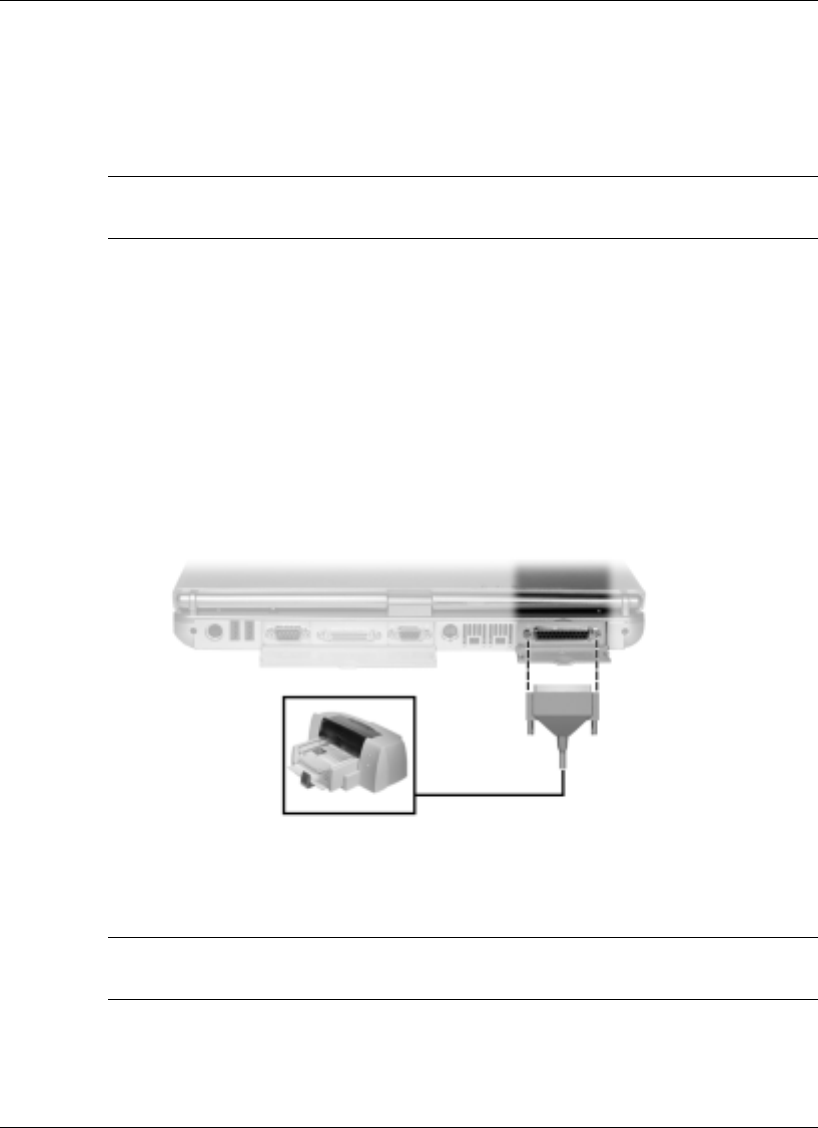
Using External Devices 8-9
Parallel Devices
To install a parallel device such as a printer, you need a cable with a male 25-pin
connector for the system and, for most parallel printers, a Centronics®-compatible
36-pin connector.
Note When you connect a printer, be sure to install the appropriate printer driver
through the Windows control panel.
Connect a parallel device to your NEC Versa as follows.
1. Check that power to both the NEC Versa and the device is off.
2. Align and connect the 25-pin parallel cable connector to the parallel port on the
system. Secure the cable with the screws provided.
3. Align and connect the other end of the cable to the parallel port on the device.
Lock the connector clips.
Connecting a parallel printer
4. Connect the power cable to the device and a properly grounded wall outlet.
5. Turn on power to the system and the device.
Note Check that the device is online before you try to use it. See the instructions
that came with the device for more information.

8-10 Using External Devices
Audio Options
The NEC Versa comes equipped with built-in audio ports that let you record and play
sound.
Connect an external microphone or headphones to the microphone in or headphone in
port on the front of the NEC Versa system. See “Front Features” in Chapter 1 for port
locations.
Note If you are using an external microphone and experience sound distortion or
feedback, lower the speaker volume.
9
Using Multimedia
! Audio
! Video
! Multimedia Applications

9-2 Using Multimedia
With its fast processor and enhanced audio and video capabilities, you can perform
fantastic multimedia feats with your NEC Versa L320! This section describes the NEC
Versa L320’s multimedia features and how you can use them to create high-quality,
powerful presentations.
Multimedia combines audio, text, animation, photo images, and video sources into one
presentation.
Audio
The NEC Versa L320 provides entertainment-level sound quality through the stereo
speakers. It handles musical instrument digital interface (MIDI) files and digital audio
files. The NEC Versa L320 recognizes .WAV, .MID, and .AVI files. The system also
provides PC99 compliant audio.
Recording
All information on a computer must be stored in digital form. Analog audio signals
from sources such as tape cassettes or music CDs must be digitized before being
recorded and stored on disk.
Note The built-in microphone is muted by default. Enable the microphone before
attempting to use it.
You can make recordings at the microphone level.
Note When using the built-in microphone, make sure the speaker volume is turned
down or feedback may occur.
The following procedure describes how to use the Sound Recorder in the Microsoft
Windows Accessories group to record sound into a file on the NEC Versa L320. (For
details, see the online help that is available when you open the Sound Recorder.)
1. Locate the Sound Recorder by sliding the cursor over Start, Programs, Accessories,
Entertainment (Windows 98/2000) or Multimedia (Windows NT), and the Sound
Recorder line. Release your finger from the VersaGlide to open the recorder. (You
may have to press the left selector button on the VersaGlide.)
2. Use the VersaGlide to press the Record button on the screen. The Record button
has a red circle in the middle.
3. Speak into the microphone to create a sound file.

Using Multimedia 9-3
4. When you finish recording, press the Stop button. Be careful when recording;
audio files can become quite large.
CD-ROM/DVD-ROM Input
You can record music and sound effects from a CD (compact disc) and store them on
your hard disk. The audio signal from the CD-ROM or DVD-ROM drive connects
directly to your NEC Versa L320. Simply follow the instructions in “Recording” to
record sound from your CD player.
Microphone
You can capture and record sounds through the internal microphone on the NEC Versa
L320 or through an external microphone that connects to the system through the
microphone port. You can record voice-overs for narration, reminders, or special
instructions.
See “Recording” earlier in this chapter, for details about recording sound with the
microphone.
Playing Back
You can play back your recorded soundtrack through stereo headphones, the internal
NEC Versa L320 stereo speakers, or external stereo speakers. You can play .WAV and
MIDI files as well as CD audio. Adjust the volume through the software (a volume
control feature can be found in Accessories or on the system tray in the Toolbar) or
with the volume control knob on the front of the system.
Play audio from files or audio devices as follows. (This example shows how to use the
Media player option in Accessories. You can also play audio by opening a file through
the Sound Recorder and pressing the Play button.)
1. Go to Programs, Accessories, Entertainment (Windows 98/2000) or Multimedia
(Windows NT), and open the Media Player.
2. Select your audio source as follows:
! If playing a file, use the File menu to specify the file name.
! If playing from a device, use the Device menu to select your audio source.
Once your file is open or your source specified, press the Play button.
3. Press the square Stop button to stop playing the audio.

9-4 Using Multimedia
Using Headphones
The NEC Versa L320 headphone port delivers sound at half a watt. Stereo headphones
plug in through the headphone jack located on the front of the NEC Versa L320. Use
the audio software that comes on your system to adjust the volume.
Note Using headphones disables the internal speakers.
Using the Built-In Speakers
The NEC Versa L320 has built-in stereo speakers. Adjust the volume through the
software or with the volume control knob located on the front of the system.
Using External Stereo Speakers
For full stereo sound impact, you can plug a pair of stereo speakers into the headphones
jack located on the front of the system. Adjust the volume through software, with the
controls on the external speakers (if equipped with controls), or with the volume
control knob on the NEC Versa L320. When using external speakers the internal
speakers are disabled.
Video
Depending on the model, the NEC Versa L320 features a TFT panel with XGA or
SXGA-Plus resolution. This enables color display for sharp effective visuals right on
the system or projected onto an external CRT monitor.
Use your NEC Versa L320 to run full motion, full-screen MPEG video. In Windows
98, the Active Movie Control gives you MPEG capabilities. In Windows NT, you must
install Internet Explorer to use the Active Movie Control function.
Access the Active Movie Control as follows:
1. Go to Start, Programs, Accessories, Entertainment, and select Active Movie
Control.
An Open dialog box displays.
2. Locate your CD-ROM drive and double click on the appropriate drive to display its
contents.
3. Open your file and press the Play button. (To play full screen MPEG video, you
may need to press the Window maximize button to bring your video to full size.)

Using Multimedia 9-5
Using Digital Video Files
With commercial video capture hardware and application software, you can plug any
video device, including VCRs, televisions, camcorders, and laser disc players into your
NEC Versa L320 and record motion graphics to your hard drive.
Use a video frame grabber and store a stream of grabbed stills on your hard disk.
Using Animation Files
You can create a dynamic presentation using an animation application. Animation can
illustrate a concept, drive home an important point, or command attention. Graphics
animation can add punch to a presentation with an animated illustration, a flashing
arrow, or a flying logo.
Multimedia Applications
A growing number of multimedia applications are available for PC/notebook users.
These multimedia software packages include graphics packages, animation software,
and presentation authoring systems as follows:
! Animation software allows you to create 3-D effects and 3-D titles and add interest
to an otherwise static presentation.
! Authoring packages let you pull all the elements of your design into an exciting,
interactive multimedia presentation.
10
Solving System Problems
! Problem Checklist
! Startup Problems
! If You Need Assistance

10-2 Solving System Problems
Once in a while you may encounter a problem with your NEC Versa L320. If the
screen is blank, the instructions don’t help, or no error message appears, use the
information here to determine and fix the problem. You still may be able to solve the
problem yourself!
Problem Checklist
First check the items in the following list. If these items don't help, see the table that
follows the list.
! Power is on to the computer.
! The electrical outlet to which your AC adapter is connected is working. Test the
outlet by plugging in a lamp or other electrical device.
! All cables are tightly connected.
! The display setting is configured correctly.
! The display’s brightness control is adjusted properly.
! If using battery power, check that the battery pack is properly inserted and fully
charged.
Troubleshooting
Problem What to Do
The system does not power
on.
If you are operating the system with battery power, check that the
battery pack is correctly inserted. Attach the AC adapter to
recharge the battery.
If you have the AC adapter attached, check that the electrical
outlet you are using works.
LCD screen is dark and blank. Power-saving mode has shut off the backlight. So try to recover
by pressing any keyboard key.
The built-in LCD may not be selected. Press Fn-F3 once or twice.
Screen brightness needs adjustment. Adjust the control (Fn-F8
and Fn-F9).
The system entered Standby mode (Windows 98/2000) due to
low battery power. Plug in the AC adapter before resuming
operation.

Solving System Problems 10-3
Troubleshooting
Problem What to Do
Battery power does not last
long.
Use power-saving modes.
Fully charge and fully discharge the battery several times to
recondition it. Use the Battery Refresh function in the Exit Menu
of the BIOS Setup utility (see “Exit Menu” in Chapter 3).
Replace the battery.
Information on the LCD screen
is difficult to see.
Adjust the brightness and contrast using the brightness and
contrast controls.
The Suspend/Resume function
does not work.
If the system does not suspend, a disk drive might be busy. Wait
until the disk drive stops and try again.
If system does not resume, it may have auto suspended on a low
battery. Attach the AC adapter and try again.
If the system still does not suspend, check that Auto Play is
disabled for the CD-ROM drive.
An optional component does
not work.
Make sure the component is securely installed or connected.
Verify that the system parameter for the I/O port configuration is
set correctly in Setup.
Startup Problems
The system displays an invalid configuration error message at power on when there are
the following conditions:
! the current configuration information doesn't match configuration information
stored in Setup, such as when an internal option is added.
! the system loses configuration information.
If either condition is true, the system displays an invalid configuration information
message.
To continue start-up procedures, press F2 and run the Setup utility to set current system
parameters.
If an error message appears before the operating system starts, look up the error
message in the following table. Follow the instructions. If you see other error messages,
the hardware might need repair.
If the system frequently loses the setup configuration data, the internal CMOS battery
may need to be replaced at an authorized NEC repair center.

10-4 Solving System Problems
POST Error Messages
The NEC Versa L320 has a built-in checking program that automatically tests its
components when you turn the system power on. This diagnostic test is called the
Power-On Self-Test (POST). If the system finds a problem during POST, the system
displays an error message. If this happens, follow the instructions in the POST error
message table.
POST Error Messages
Error Message Explanation
Diskette drive A error Drive A: is present but fails the BIOS POST diskette tests. Check
to see that the drive is defined with the proper diskette type in
Setup.
Extended RAM Failed at offset:
nnnn
Extended memory not working or not configured properly at offset
nnnn.
Failing Bits: nnnn The hex number nnnn is a map of the bits at the RAM address (in
System, Extended, or Shadow memory) which failed the memory
test. Each 1 (one) in the map indicates a failed bit.
Fixed Disk 0/1/Disk Controller
Failure
Fixed disk is not working or not configured properly. Check to see
if fixed disk is attached properly. Run Setup to make sure the
fixed-disk type is correctly identified.
Incorrect Drive A type – run
SETUP
Type of floppy drive A: not correctly identified in Setup.
Keyboard Controller error The keyboard controller failed test. You may have to replace
keyboard or controller.
Keyboard Error – Keyboard not
working
Keyboard error nn BIOS discovered a stuck key and displays the
scan code nn for the stuck key.
Operating system not found Operating system cannot be located on either drive A: or drive C:.
Enter Setup and see if fixed disk and drive A: are properly
identified.
Parity Check 1 – Parity error
found in the system bus
BIOS attempts to locate the address and display it on the screen.
If it cannot locate the address, it displays ????.
Parity Check 2 – Parity error
found in the I/O bus
BIOS attempts to locate the address and display it on the screen.
If it cannot locate the address, it displays ????.

Solving System Problems 10-5
POST Error Messages
Error Message Explanation
Previous POST did not
complete successfully.
POST loads default values and offers to run Setup. If the failure
was caused by incorrect values and they are not corrected, the
next boot will likely fail. On systems with wait states, improper
Setup settings can also terminate POST and cause this error on
the next boot. Run Setup and verify that the wait-state
configuration is correct. This error is cleared the next time the
system is booted.
Real time clock error Real-time clock fails BIOS test. It may require board repair.
Shadow Ram Failed at offset:
nnnn
Shadow RAM failed at offset nnnn of the 64k block at which the
error was detected.
System battery is dead –
Replace and run SETUP
The CMOS clock battery indicator shows the battery is dead.
Replace the battery and run Setup to reconfigure the system.
System cache error – Cache
disabled
RAM cache failed the BIOS test. BIOS disabled the cache.
System CMOS checksum bad
– run SETUP
CMOS has been corrupted or modified incorrectly, perhaps by an
application program that changes data stored in CMOS. Run
Setup and reconfigure the system either using the Default Values
and/or making your own selections.
System RAM Failed at offset:
nnnn
System RAM failed at offset nnnn of the 64k block at which the
error was detected.
System timer error The timer test failed. Requires repair of system board.
If You Need Assistance
If you have a problem with your computer, first review the checklist and
troubleshooting table in the previous section.
If you still have a problem, see Chapter 11, “Getting Service and Support,” for details
about contacting NEC.
Note If you purchased and are using this product outside the U.S. or Canada,
please contact the local NEC office or their dealers for the support and service available
in your country.

11
Getting Service and Support
! Service and Support Contact Information
! Web Site
! Support Services
! E-mail to Support Services

11-2 Getting Service and Support
Service and Support Contact Information
Service Contact Information
NEC Computers Inc. Web Site www.neccomp.com
Support Services Web Site support.neccomp.com
Support Services (U.S. and
Canada customers only).
1-800-632-4525
E-mail to Support Services through
a commercial online service or the
Internet.
Internet e-mail address:
tech-support@nec-computers.com
Note If you purchased your computer outside the U.S. or Canada, please contact
the local NEC office or their dealers for support and service.
If you have access to a telephone, a modem, and/or a LAN Internet connection, you can
use these services to obtain information about your system at any time, day or night,
seven days a week.
Not only do these services provide information about your NEC system, they can also
be used to answer your questions and help solve any problems you may have with your
system, should that ever be necessary.

Getting Service and Support 11-3
Web Site
If you have a modem or are connected to a network, you can access the NEC
Computers Web site. You can do this through a commercial online service or through
your Internet account. The web site contains general information about NEC
Computers and its products, press releases, reviews, a reseller locator, and service and
support information.
Look in the Service and Support area for the following:
! technical documentation, including Frequently Asked Questions, reference manuals,
and warranty information
! BIOS updates, drivers, and Setup Disk files to download
! contact information, including telephone numbers for Technical Support and links
to vendor web sites
! an automated e-mail form for your technical support questions
! a password-accessible area for resellers.
To access The NEC Computers Home Page, enter the following Internet Uniform
Resource Locator (URL) in your browser:
http://www.neccomp.com/
To access The NEC Computers Support Page, enter the following Internet Uniform
Resource Locator (URL) in your browser:
http://support.neccomp.com/

11-4 Getting Service and Support
Support Services
NEC Computers also offers direct technical support through Support Services. (NEC
Computers Support Services is for U.S. and Canadian customers only; international
customers should contact the local NEC office or dealer for the support and service
available in their country.)
Direct assistance is available 24 hours a day, 7 days a week. Call NEC Computers
Support Services, toll free, at 1-800-632-4525 (U.S. and Canada only) for system
hardware support and to find out about the extended service programs available for
purchase. Toll-free phone support is limited to the length of the three-year limited
warranty.
Please have your system accessible while calling for technical support to ensure that
NEC Computers support personnel can successfully troubleshoot your system.
For outside the U.S. or Canada, please contact your local NEC office or dealer for the
support and service available in your country.
E-mail to Support Services
The NEC Computers Support Services offers technical support by e-mail if you have
Internet access. The e-mail address is:
tech-support@nec-computers.com
When using the e-mail support service, you should include the word “Notebook” in the
subject field for prompt response from the appropriate technical person.
You should provide as much specific information about your questions as possible.
You will receive a response to your questions, usually within one business day.
A
Setting Up a Healthy Work Environment
! Making Your Computer Work for You
! Arrange Your Equipment
! Adjust Your Chair
! Adjust Your Input Devices
! Adjust Your Screen or Monitor
! Vary Your Workday
! Pre-existing Conditions and Psychosocial Factors

A-2 Setting Up a Healthy Work Environment
Making Your Computer Work for You
Computers are everywhere. More and more people sit at computers for longer periods
of time. This appendix explains how to set up your computer to fit your physical needs.
This information is based on ergonomics — the science of making the workplace fit the
needs of the worker.
Some nerve, tendon, and muscle disorders (musculoskeletal disorders) may be
associated with repetitive activities, improper work environments, and incorrect work
habits. Examples of musculoskeletal disorders that may be associated with certain
forms of repetitive activities include: carpal tunnel syndrome, tendinitis, tenosynovitis,
de Quervain’s tenosynovitis, and trigger finger, as well as other nerve, tendon, and
muscle disorders.
Note Prolonged or improper use of a computer workstation may pose a risk of
serious injury. To reduce your risk of injury, set up and use your computer in the manner
described in this appendix.
Although some studies have shown an association between increasing hours of
keyboard use and the development of some musculoskeletal disorders, it is still unclear
whether working at a computer causes such disorders. Some doctors believe that using
the keyboard and mouse may aggravate existing musculoskeletal disorders.
Note Contact a doctor if you experience pain, tenderness, swelling, burning,
cramping, stiffness, throbbing, weakness, soreness, tingling and/or numbness in the
hands, wrists, arms, shoulders, neck, back, and/or legs.
Some people are more susceptible to developing these disorders due to pre-existing
conditions or psychosocial factors (see “Pre-existing Conditions and Psychosocial
Factors” later in the appendix).
To reduce your risk of developing these disorders, follow the instructions in this
appendix. If you experience discomfort while working at your computer or afterwards,
even at night, contact a doctor as soon as possible. Signs of discomfort might include
pain, tenderness, swelling, burning, cramping, stiffness, throbbing, weakness, soreness,
tingling and/or numbness in the hands, wrists, arms, shoulders, neck, back, and/or legs.
Note To increase your comfort and safety when using your notebook computer as
your primary computer system at your home or office, note the following
recommendations:
Use a separate, external keyboard attached to your notebook computer.
Use a separate, external monitor attached to your notebook computer.

Setting Up a Healthy Work Environment A-3
Arrange Your Equipment
Arrange your equipment so that you can work in a natural and relaxed position. Place
items that you use frequently within easy reach. Adjust your workstation setup to the
proper height (as described in this appendix) by lowering the table or stand that holds
your computer equipment or raising the seat height of your chair. Position your
notebook computer directly in front of you for increased safety and comfort.
Adjust Your Chair
Your chair should be adjustable and stable. Vary your posture throughout the day.
Check the following:
! Keep your body in a relaxed yet upright position. The backrest of your chair should
support the inward curve of your back.
! Use the entire seat and backrest to support your body. Tilt the backrest slightly
backwards. The angle formed by your thighs and back should be 90° or more.
! Your seat depth should allow your lower back to comfortably contact the backrest.
Make sure that the backs of your lower legs do not press against the front of the
chair.
! Extend your lower legs slightly so that the angle between your thighs and lower
legs is 90° or more.
! Place your feet flat on the floor. Only use a footrest when attempts to adjust your
chair and workstation fail to keep your feet flat.
! Be sure that you have adequate clearance between the top of your thighs and the
underside of your workstation.
! Use armrests or forearm supports to support your forearms. If adjustable, the
armrests or forearm supports should initially be lowered while all the other
adjustments discussed in this appendix are made. Once all these adjustments are
completed, raise the armrests or adjust the forearm supports until they touch the
forearms and allow the shoulder muscles to relax.

A-4 Setting Up a Healthy Work Environment
Adjust Your Input Devices
Note the following points when positioning your notebook computer or any external
input devices.
! Position your keyboard directly in front of you. Avoid reaching when using your
keyboard or mouse.
! If you use a mouse, position it at the same height as the keyboard and next to the
keyboard. Keep your wrists straight and use your entire arm when moving a mouse.
Do not grasp the mouse tightly. Grasp the mouse lightly and loosely.
! Adjust the keyboard height so that your elbows are near your body and your
forearms are parallel to the floor, with your forearms resting on either armrests or
forearm supports, in the manner described previously. If you do not have armrests
or forearm supports, your upper arms should hang comfortably at your sides.
! Adjust the keyboard slope so that your wrists are straight while you are typing.
! Type with your hands and wrists floating above the keyboard. Use a wrist pad only
to rest your wrists between typing. Avoid resting your wrists on sharp edges.
! Type with your wrists straight. Instead of twisting your wrists sideways to press
hard-to-reach keys, move your whole arm. Keep from bending your wrists, hands,
or fingers sideways.
! Press the keys gently; do not bang them. Keep your shoulders, arms, hands, and
fingers relaxed.
Adjust Your Screen or Monitor
Correct placement and adjustment of the screen or external monitor can reduce eye,
shoulder, and neck fatigue. Check the following when you position the screen or
external monitor.
! Adjust the height of your screen or external monitor so that the top of the screen is
at or slightly below eye level. Your eyes should look slightly downward when
viewing the middle of the screen or external monitor.
! Position your screen or external monitor no closer than 12 inches and no further
away than 28 inches from your eyes. The optimal distance is between 14 and 18
inches.
! Rest your eyes periodically by focusing on an object at least 20 feet away. Blink
often.
! Position the screen or external monitor at a 90° angle to windows and other light
sources to minimize glare and reflections. Adjust the monitor tilt so that ceiling
lights do not reflect on your screen or external monitor.

Setting Up a Healthy Work Environment A-5
! If reflected light makes it hard for you to see your screen or external monitor, use an
anti-glare filter.
! Clean your screen or external monitor regularly. Use a lint-free, non-abrasive cloth
and a non-alcohol, neutral, non-abrasive cleaning solution or glass cleaner to
minimize dust.
! Adjust the screen or external monitor’s brightness and contrast controls to enhance
readability.
! Use a document holder placed close to the screen or external monitor.
! Position whatever you are looking at most of the time (the screen or reference
material) directly in front of you to minimize turning your head while you are
typing.
! Get regular eye check-ups.
Vary Your Workday
If you use your computer for prolonged periods, follow these instructions.
! Vary your tasks throughout the day.
! Take frequent short breaks that involve walking, standing, and stretching. During
these breaks, stretch muscles and joints that were in one position for an extended
period of time. Relax muscles and joints that were active.
! Use a timer or reminder software to remind you to take breaks.
! To enhance blood circulation, alter your sitting posture periodically and keep your
hands and wrists warm.
Note For more information on workstation setup, see the American National
Standard for Human Factors Engineering of Visual Display Terminal Workstations.
ANSI/HFS Standard No. 100-1988. The Human Factors Society, Inc., P.O. Box 1369,
Santa Monica, California 90406.
Pre-existing Conditions and Psychosocial Factors
Pre-existing conditions that may cause or make some people more susceptible to
musculoskeletal disorders include the following: hereditary factors, vascular disorders,
obesity, nutritional deficiencies (e.g., Vitamin B deficiency), endocrine disorders (e.g.,
diabetes), hormonal imbalances, connective tissue disorders (e.g., arthritis), prior
trauma (to the hands, wrists, arms, shoulders, neck, back, or legs), prior
musculoskeletal disorders, aging, fluid retention due to pregnancy, poor physical
conditioning and dietary habits, and other conditions.

A-6 Setting Up a Healthy Work Environment
Psychosocial factors associated with these disorders include: workplace stress, poor job
satisfaction, lack of support by management, and/or lack of control over one’s work.
Contact a doctor if you experience pain, tenderness, swelling, burning, cramping,
stiffness, throbbing, weakness, soreness, tingling and/or numbness in the hands, wrists,
arms, shoulders, neck, back, and/or legs.
This appendix was prepared in consultation with Dr. David Rempel of the University of
California/San Francisco Ergonomics Program and Mr. M.F. Schneider of
HUMANTECH, Inc., Ann Arbor, Michigan.
B
Specifications
! System Components
! Interrupt Controllers
! Memory Map

B-2 Specifications
System Components
Note Components may vary. The specifications provided in this section are similar,
but not necessarily identical to those in your system.
System Processor
! Mobile Intel Pentium III Processor-M featuring Intel SpeedStep™
technology — 933 MHz, 1 GHz, 1.13 GHz or higher
! 133-MHz Front-Side Bus (FSB)
Random Access Memory (RAM)
! Standard Main Memory — 1x256 MB high-speed interleaved access; supports
PC133 memory
! Optional Expansion — 1 SO-DIMM slot
— Requires PC133 memory
— Expandable in 128-MB, 256-MB, or 512 MB (when available) increments
— Maximum 1GB total
Note If upgrading after initial purchase, the memory module provided with the
system may have to be replaced with an optional larger memory module in order to
achieve the maximum capacity.
! Video RAM — 16.0 MB
! Cache RAM — 512-KB L2 cache
Read-Only Memory (ROM)
512-KB flash ROM
Calendar Clock
Year/month/day/hour/minute/second maintained by internal back-up battery
Input/Output (I/O) Facilities
Integrated industry-standard interfaces
! Modem Port — 1 port, RJ-11 jack on some models
! LAN Port — 1 port, RJ-45 jack on some models
! S-Video Out — 1 port, supports RCA with exchange cable

Specifications B-3
! IEEE 1394 — 2 ports, 1394 standard bus
! DC In — 1 port for AC adapter cable
! PS/2 Port — 1 port, PS/2, 6-pin MiniDin
! Parallel — 1 port, 25-pin D-sub
! USB Ports — 2 ports, base connector
! Expansion — 1 port for NEC Cable PortBar
! Serial — 1 port, 9-pin D-sub
! VGA — 1 port, 15-pin high-density D-sub
! Infrared — 1 port
! Microphone — 1 port, 3-pin, Mini-Pin jack
! Headphones — 1 port, 3-pin, Mini-Pin jack
! Bluetooth support — for Bluetooth module, and Bluetooth-compliant devices when
available
Primary Battery
Lithium ion (Li-Ion), eight cell, 14.4V
Secondary Battery
! Housed in Modular Bay
! Swappable
! Lithium ion (Li-Ion), 8-cell, 14.4V
AC Adapter
! Input Voltage 100 to 240 volts (V) AC, 50 watt (max.)
! Output Voltage 19 volts DC, 3.16A
Card Slots
Two 32-bit card slots for two Type II or one Type III PC Card

B-4 Specifications
LCD
Extended Graphics Array (XGA) or Super XGA+ (SXGA+) LCD panel
! XGA LCD panel is a 14- or 15-inch high-resolution active-matrix Thin Film
Transistor (TFT) color display
Resolution — 1024 × 768 max
Colors — up to 16.8 million
! SXGA+ LCD panel is 15-inch color active-matrix TFT color display; high-contrast
ratio; low power consumption
Resolution — 1400 × 1050 max
Colors — up to 262,144
Keyboard
Membrane-type, with standard QWERTY-key layout (International keyboards are
country specific)
! Function keys — 12 keys
! Personal Code keys (on some systems)
! Internet and Email keys
! Cursor Control keys — 8 keys; including 4 arrow keys arranged in inverted
T layout
! Numeric keypad — embedded
! Special Windows 95 keyset
! Fn key — function key for ROM-based key functions
External Bays
! NEC VersaBay IV — houses CD-ROM, DVD-ROM, CD-RW, or DVD-ROM/
CD-RW drive (one comes with system); optional hard drive in a cradle; or weight-
saving module)
! NEC Modular Bay — houses diskette drive, optional secondary battery, or weight-
saving module)

Specifications B-5
Diskette Drive
Standard 1.44 MB in Modular Bay
! Size — 3.5 inch
! Capacity — 1.44 MB (formatted), 2 MB (unformatted)
Note When referring to storage capacity, MB stands for one million bytes. Some
utilities may indicate varying storage capacities. Total user-accessible capacity may vary
depending on operating environments.
Hard Disk Drives
! Internal, 2.5 inch, IDE
! Can be placed in optional cradle for use in NEC VersaBay slot
! Capacity (depending on the model) 15-GB, 20-GB, 30-GB or larger hard disk drive
Note When referring to storage capacity, GB stands for one billion bytes. Some
utilities may indicate varying storage capacities. Total user-accessible capacity may vary
depending on operating environments.
CD-ROM Drive
! Housed in NEC VersaBay IV slot
! Thin-type CD-ROM pack
! Access Time — up to 24X maximum/12x minimum variable speed
! Interface — IDE (ATAPI)
! Photo CD Compatibility — Multisession Photo CD, Single Session Photo CD,
Video CD, CS-I, CD-I Ready, CD-G and CD-Plus
DVD-ROM Drive
! Housed in NEC VersaBay IV slot
! Burst Transfer Rate — 16.67 MB/sec, PIO/Multiword DMA
! Spin Up Time, 2.5s (DVD), 2.0s (CD)
! Read Rate
— CD, 10.3X – 24X, approximately 5,100 rpm
— DVD, 4X – 7.5X, approximately 1,200 – 2,000 rpm

B-6 Specifications
! Access Time
— Average random access, 100 ms (DVD), 95 ms (CD 24X)
— Average random seek, 95 ms (DVD), 90 ms (CD 24X)
— Full stroke, 160 ms (DVD), 160 ms (CD 24X)
! Data Buffer — 128 KB
! Interface — IDE (ATAPI)
! CD Compatibility — CD-DA, CD+G, CD MIDI, CD-TEXT, CD-ROM, CD-ROM
XA, CD-I Bridge (Photo-CD, Video CD), CD-I, Multisession CD (Photo-CD, CD-
Extra, CD-RW, CD-R), CD-R (read), CD-RW (read)
! DVD Compatibility — DVD-5, DVD-9, DVD-10, DVD-18, DVD-R (read, single
border)
CD-RW Drive
! Housed in NEC VersaBay IV slot
! Speed
— Read, up to 20x maximum variable speed
— CD-RW, up to 14x maximum variable speed
! Read Transfer Rate
— 150 KB/s, normal speed
— 3000 KB/s, 20X, maximum speed
! Write Transfer Rate
— 150 KB/s, normal speed
— 300 KB/s, 2X speed
— 600 KB/s, 4X speed
! Audio Out — 0.8 +/-0.25 Vrms
! Operating Conditions
— Shock, 1G (11ms)/read, 0.5G (11ms)/write
— Vibration, 0.2G/read, 0.1G/write

Specifications B-7
DVD-ROM and CD-RW Combination Drive
! Housed in NEC VersaBay IV slot
! Data capacity
— DVD, 2,048 bytes/block
— CD, 2048 bytes/block (mode 1), 2,336 bytes/block (mode 2)
! Rotational speed
— DVD, 3,792 (2.5 – 6X CAV)
— DVD-Video, 1,377-2,222 rpm (1.6X – 2.4X PCAV)
— CD, 5,100 rpm (10.3 – 24X CAV)
— CD-RW, 1,200 – 2000 rpm (4 – 5.7X PCAV)
— Video-CD, 1,200 – 2000 rpm (4 – 5.7X PCAV)
— CD-R/CD-RW (Write), 850 – 1,980 rpm (4X CLV)
420 – 990 rpm (2X CLV)
! Sustained data transfer rate
— DVD, 3,357 – 8,112 kbytes/sec (2.5 – 6X CAV)
— DVD-Video, 2,163 – 3,245 kbytes/sec (1.6X – 2.4X PCAV)
— CD, 1,552 – 3,600 kbytes/sec, mode 1 (10.3X – 24X CAV)
1,769 – 4,104 kbytes/sec, mode 2 (10.3X – 24X CAV)
! Access time (typical)
— Average random access, 120 ms (DVD), 110 ms (CD)
— Average random seek, 115 ms (DVD), 105 ms (CD)
— Average full stroke, 180 ms (DVD), 170 ms (CD)
! Spin up, 2.5s (DVD), 2.0s (CD)
! Data buffer, 2 MB
! Power Supply, +5V
! Dimensions (W x H x D)
— 5.04 x .5 x 4.96 in.
— 128 x 12.7 x 126.1 mm

B-8 Specifications
MDC Modem (built-in)
! K56flex™ compatible
! V.34 extended rate protocol
! V.90 compliant
! Enhanced AT command set
! Class 1 and 2 Fax protocols
! Built-in speaker with software controllable volume
Mini PCI LAN
! 10Base-T and 100Base-TX
! Resume-on-LAN support
! Full duplex support
! Software support for management server
Wireless Mini PCI LAN (built-in)
! IEEE 802.11b High Rate standard for wireless LANs (DSSS)
! Wi-Fi certified by WECA
! Transmit rate — 11-Mbps high speed
! R-F frequency band — 2.4 GHz, data rate
! Range of up to 1200 feet.
! 128-bit RC4 encription
! Integrated antenna
Security
! Kensington lock slot
! Hard Disk Drive security for internal drive
! Personal code access available on some systems

Specifications B-9
Dimensions
System
! Width — 12.8 in (327 mm) max
! Depth — 10.4 in. (268 mm) max
! Height — 1.5 in. to 1.6 in. (39.2 mm to 40.5 mm)
Weight
! Minimum 7.1 lbs. (3.2kg)
Recommended Environment
Operation
! Temperature — 41ºF to 95ºF (5ºC to 35ºC)
! Relative Humidity — 20% to 80% (Noncondensing)
Storage
! Temperature — –4ºF to 104ºF (–20ºC to 40ºC)
! Relative Humidity — 20% to 80% (Noncondensing)

B-10 Specifications
Interrupt Controllers
The following table shows default interrupt level assignments 0 through 15.
Note These resources may change after this user’s guide goes to print. Please refer
the NEC Versa L320 Release Notes that came with your NEC Versa L320.
Interrupts
IRQ# Device
IRQ00 Internal Timer
IRQ01 Keyboard
IRQ02 PIC
IRQ03 IR
IRQ04 Serial Port
IRQ05 CardBus/Mini-PCI/AC Link/Firewire
IRQ06 Diskette Drive
IRQ07 Parallel Port
IRQ08 Real-time Clock
IRQ09 USB (2) / SCI (only ACPI)
IRQ10 CardBus/Mini-PCI/AC Link/Video/Firewire
IRQ11 Available
IRQ12 Mouse
IRQ13 Coprocessor
IRQ14 Hard Disk Controller
IRQ15 Available

Specifications B-11
Memory Map
The system supports system and video shadowing, both controlled through
complementary metal oxide semiconductor (CMOS). The system supports BIOS as a
cacheable area with write protection. The following table shows the system’s memory
map.
System Memory Map
Memory Space Size Function
00000000h-0009FFFFh 640 KB System Memory
000A0000h-000BFFFFh 128 KB Video Memory
000C0000h-000DFFFFh 128 KB
000E0000h-000FFFFFh 128 KB System and Video BIOS
01000000h-01FFFFFFh 32 MB Extended Memory
02000000h-03FFFFFFh 32 MB Extended Memory
04000000h-0FFFFFFFh Up to 256 MB Extended Memory

C
Frequently Asked Questions
! External Mouse
! Display
! PC Cards
! Diskette Drive
! Booting
! Power Management
! Miscellaneous
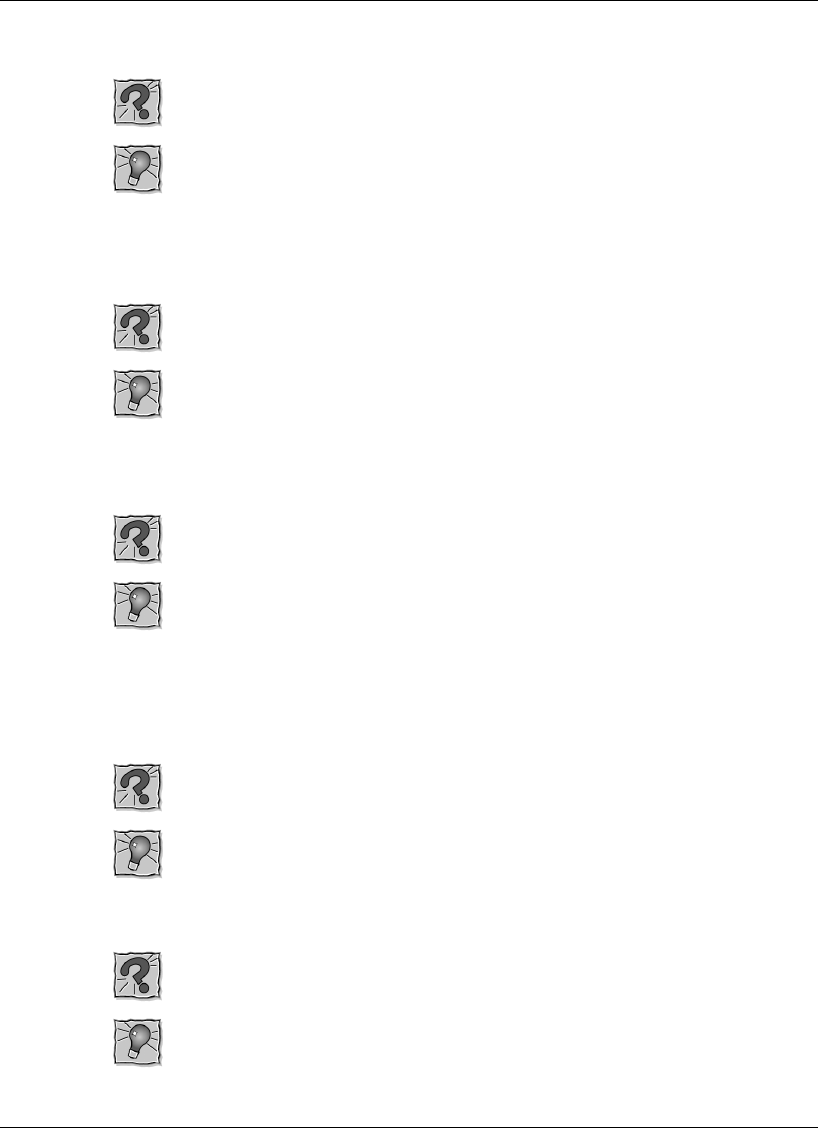
C-2 Frequently Asked Questions
External Mouse
How can a mouse and an external keyboard be connected to the notebook
at the same time?
The NEC Versa L320 is equipped with two USB ports that allow you to
connect any combination of two USB devices, at the same time. If you
purchase a USB mouse and a USB keyboard, simply plug each device into
any of the USB ports on your system.
Display
What is the maximum resolution I can run in simultaneous mode?
The maximum resolution in simultaneous mode is 1400 x 1050 for SXGA+
TFT or 1024 x 768 for XGA TFT panels, depending on the capabilities of the
external monitor. You can obtain higher resolutions if you connect a higher-
resolution external monitor and switch to CRT-only mode.
How can I change my video drivers?
Go to Start, Settings, Control Panel, and double click the Display icon. Click
the Settings tab, click Advanced Properties, and click Change. Click Show all
devices from the Select Device screen. Find the video driver you need, or
insert a diskette or CD into the appropriate drive. Click on Have Disk and
follow the on-screen instructions to install a new video driver.
PC Cards
In which slots do my PC Cards go?
Your PC Cards can go into either slot if they are NEC-approved cards. Other
software may not support the use of both slots. Type III cards only fit in the
bottom slot (slot 0).
Is there any instance when a modem or network card is only supported in
one slot?
This could be true in cases where the PC Card firmware is being upgraded.
Read the release notes that accompany the upgrade.
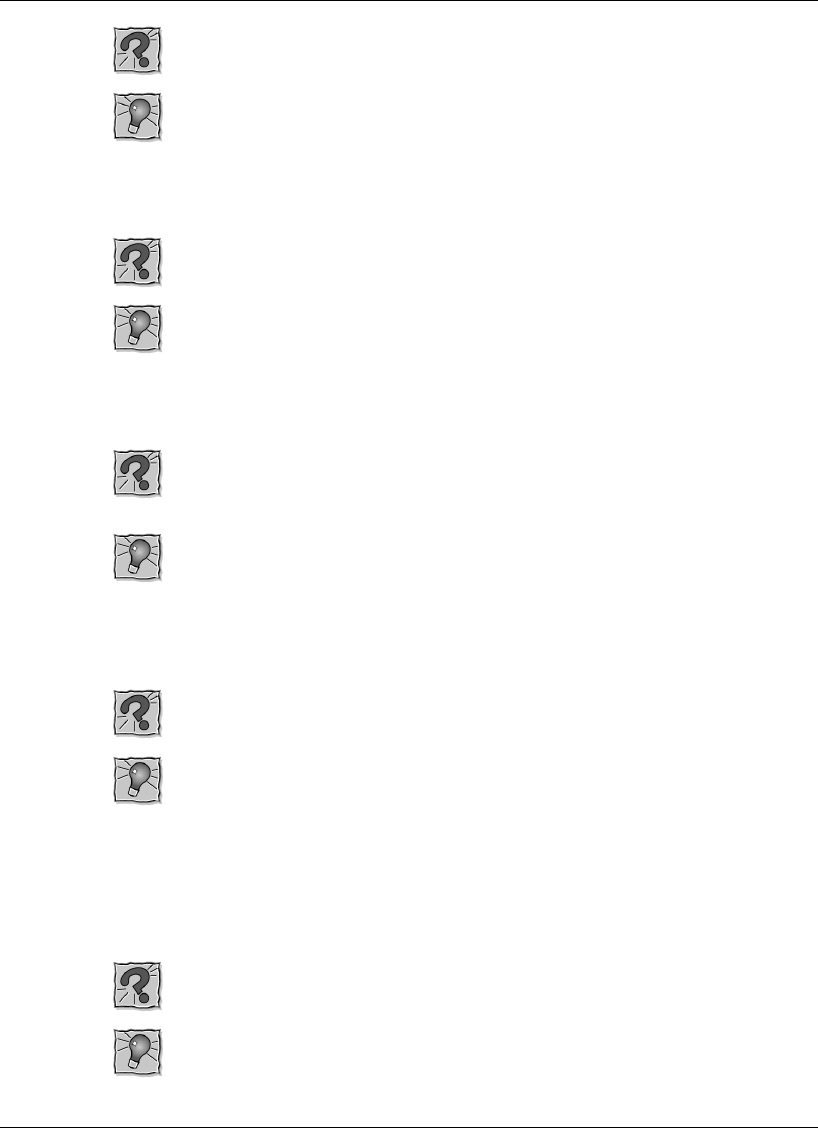
Frequently Asked Questions C-3
Can I run two of the same type cards simultaneously?
Yes, Windows configures each card. If they are both modems, configure each
for a different Com port and different available interrupts under the Device
Manager in Windows. Click Start, Settings, Control Panel, System, Hardware
(Windows 2000 only), Device Manager.
Why do certain PC Cards cause my battery life to drop noticeably?
Certain hard disk cards and wireless radio cards consume more power than
others and can impact battery life. When not using any PC Card, close all
applications using the card and pop it part of the way out of the slot to save
power.
In Setup, I disabled or reconfigured peripheral devices (like the ports or
sound), yet I am unable to use the freed IRQs or I/O address resources
with my PC Cards?
To provide a stable platform free of conflicts, NEC Computers excluded some
resources from PC Card use.
Diskette Drive
Why can’t I boot from the diskette drive?
To boot from the diskette drive, be sure that you have a diskette in the drive
containing operating system files. Be sure to check the Boot menu parameters
in the BIOS Setup Utility to determine the designated sequence of boot
devices. See Chapter 3, “Using the BIOS Setup Utility.”
See your operating system documentation for information about creating
system diskettes.
What happens if I leave a diskette in my diskette drive?
Shutting down your system with a diskette in the drive can damage the data on
your diskette and your drive. Remove the diskette before powering off.
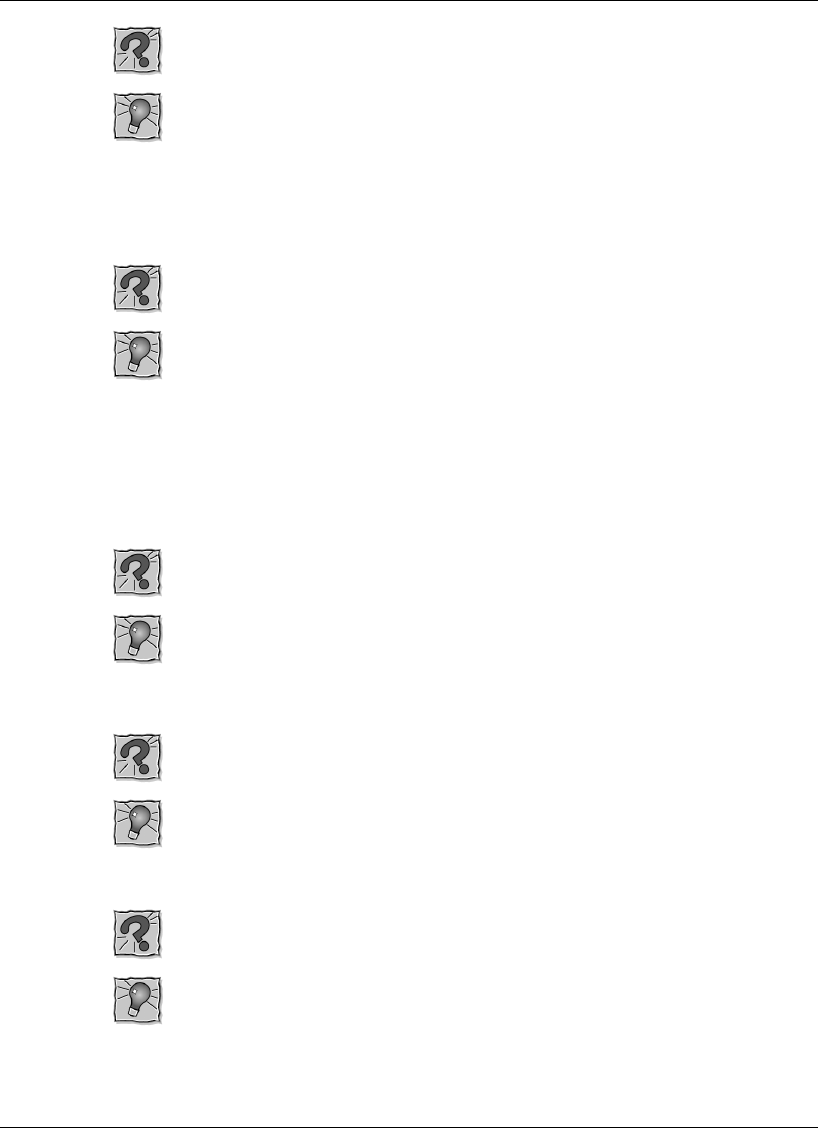
C-4 Frequently Asked Questions
How do I format a diskette?
Double click on the My Computer icon and then right click (click the right-
hand mouse button) on the diskette drive icon. Select Format and choose the
format process that best suits your needs.
To format high density 1.44-MB* diskettes in DOS, type format a: and press
Enter. If you want a bootable diskette, type format a:/s and press Enter.
What type of diskette do I use in my diskette drive?
Your NEC Versa L320 ships with a 1.44-MB* diskette drive that uses 3.5-
inch high density (HD) diskettes. These diskettes are also called double-sided,
high-density (DSHD) diskettes. You can store 1.44 MB* of information on
these diskettes.
Your diskette drive can also use 3.5-inch double-sided, double-density
(DSDD) diskettes. These diskettes only hold 720 kilobytes of data – about
half the amount of data that 1.44-MB* diskettes hold.
Why does the amount of available storage displayed for the diskette drive
vary between utilities?
Some utilities may indicate varying storage capacities. Total user-accessible
capacity may vary depending on operating environments.
Booting
How do I warm boot my computer?
In Windows 2000 or Windows 98 SE, press Ctrl, Alt, and Del twice to restart
the system or go to Start, Shut Down, Restart the computer. In DOS mode,
press Ctrl, Alt, and Del to warm boot the system.
How do I cold boot my computer?
Press the system’s Power button to perform a cold boot or go to Start, Shut
Down, to shut down the computer. Wait at least five seconds, and then turn
the power on.
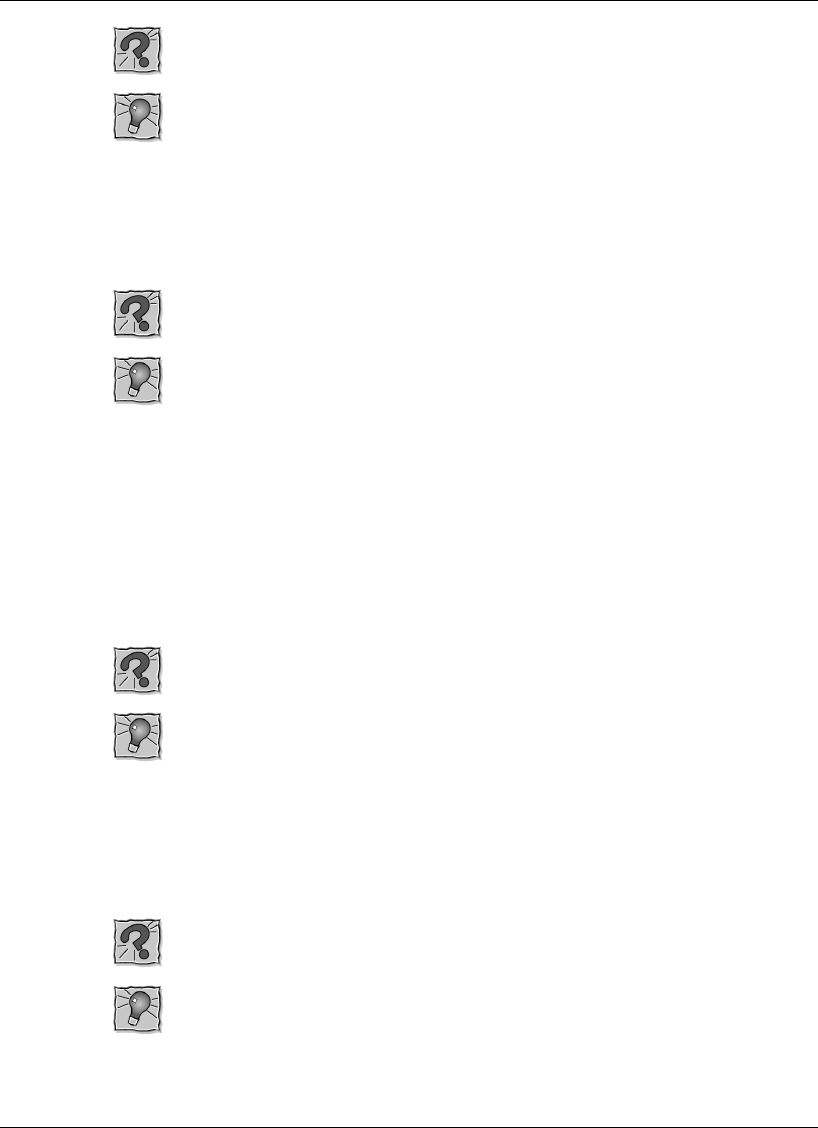
Frequently Asked Questions C-5
What is the difference between a warm boot and a cold boot?
A warm boot restarts the system while system power is on. A warm boot is
also a software reset. A warm boot clears volatile system memory and reloads
the operating system.
A cold boot is a system start with power off. A cold boot also resets the
hardware. It checks the hardware and reloads the operating system.
Power Management
Does my system come with power management features enabled?
Your system’s default settings are configured with power management
features enabled when on DC (battery) power and disabled when on AC
power. Use the BIOS Setup Utility to modify the default settings, if desired.
If you do not use the keyboard, mouse, or drives for the preset length of
inactive time, your screen goes blank and your system goes into a power
saving mode of operation. This is known as an LCD timeout.
When your screen goes blank, before the system goes into Standby mode
(power status LED blinks), just press the space bar or move your mouse to
reactivate your system.
What is the purpose of Suspend to RAM (Standby)?
You can initiate full Suspend-to-RAM by accessing Start, Shut Down,
Standby. This places the system in a deeper state of “sleep” and requires that
you press the Power button to resume operation.
Putting your system into Standby initiates the Standby power-saving mode
and is a convenient way of conserving energy when you are going to be away
from your system for a short period of time.
What is the function of Suspend-to-File (Hibernation)?
Suspend-to-File (Hibernation) provides the greatest power savings by putting
the system into a maximum power shutdown. When the system goes into STF
mode, it saves data and system status and then shuts off power to all
components. STF mode lets you save power without first saving your work.
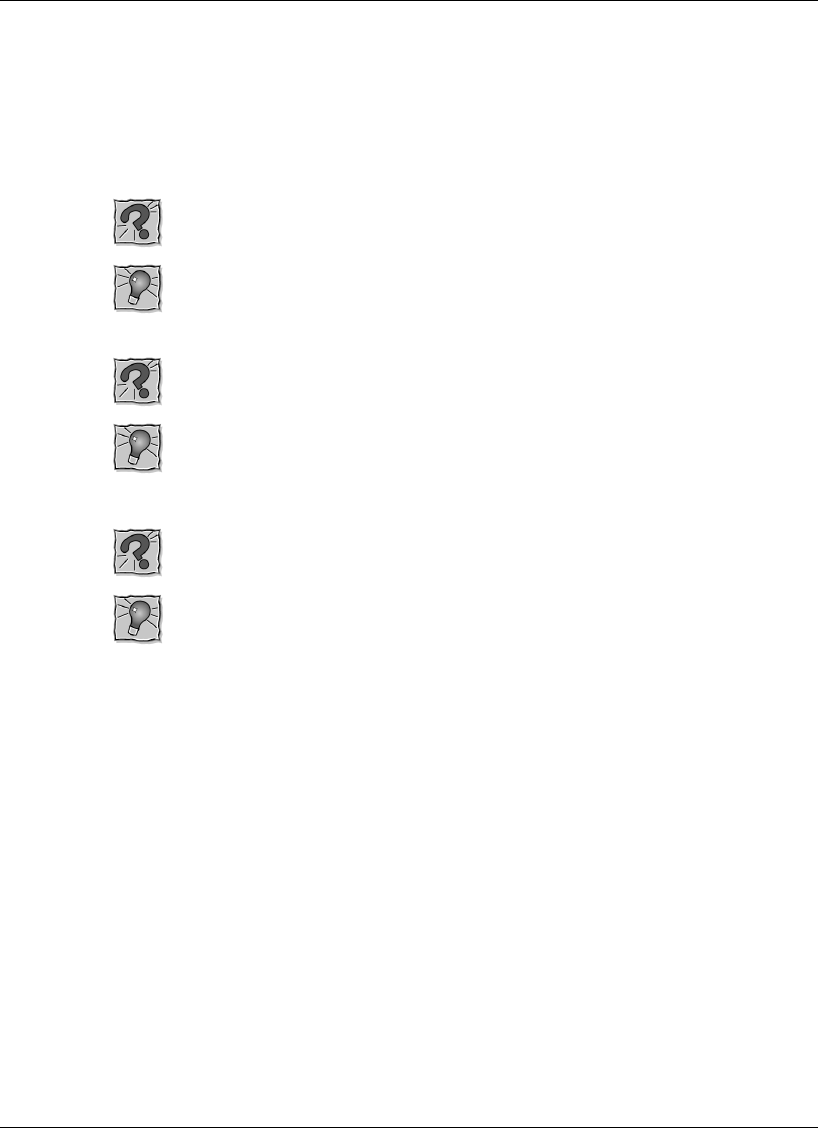
C-6 Frequently Asked Questions
Resuming from STF mode requires less time than performing a cold boot.
Your system must be configured for STF/Hibernation. In Windows Power
Management Properties, check the box labeled “enable hibernate support,”
under the Hibernate tab. In the BIOS Power Management Setup, enable the
“Auto save-to-file” parameter and set the “Suspend Option” to STF.
How do I bring my system out of Standby mode?
Pressing the Power button brings the system out of Standby mode.
What is a timeout?
A timeout is the amount of time your system or a particular component is
inactive.
What can I do to conserve battery power?
There are several ways to conserve battery power, and this is an important
activity, particularly if you frequently use your system in situations when you
can’t operate your system on AC power.
Try using your system with a lower screen illumination to conserve battery.
Run your system on battery power with Intel SpeedStep2 technology enabled.
This allows the processor to run at a lower speed during non-intensive
processor operations, and consequently conserves your battery.
There are also activities that draw larger amounts of battery power. If
possible, operate your system on AC power in these circumstances to
conserve your battery. For example, NEC Computers recommends running
the system on AC power while using external devices such as a printer or a
USB drive, when connected to a network, or while playing DVD movies.
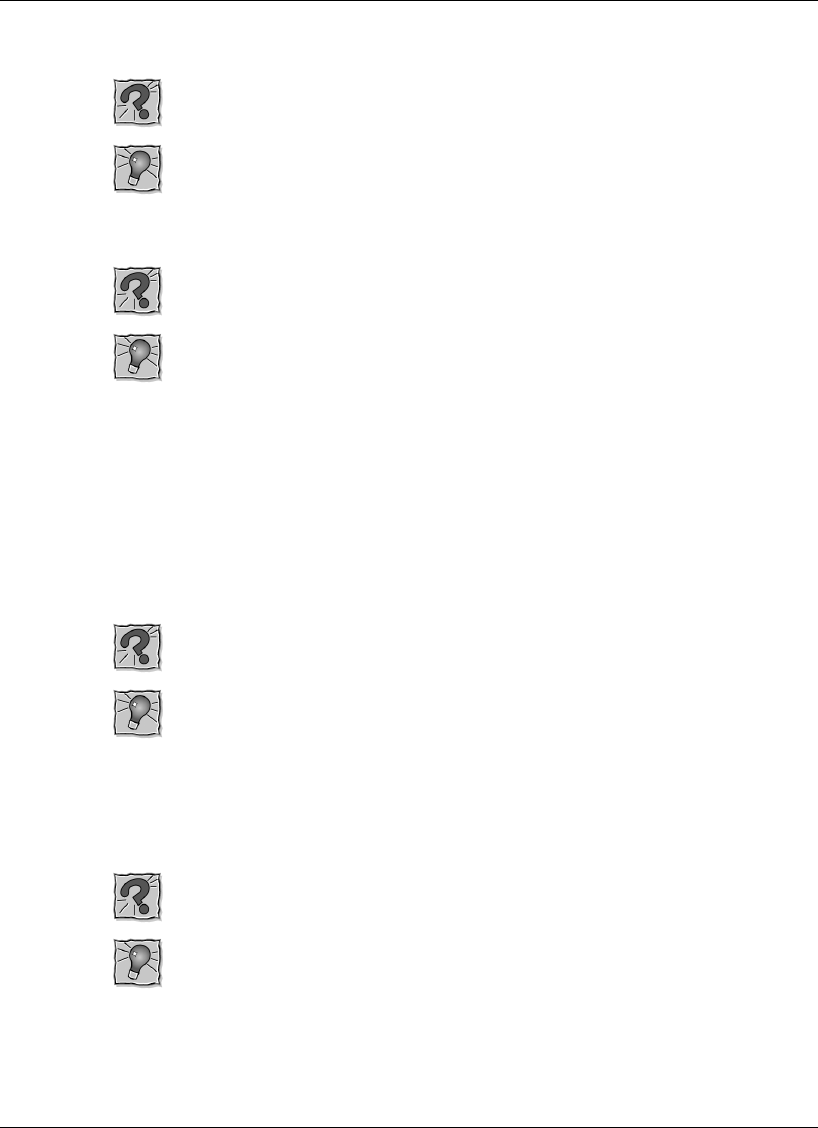
Frequently Asked Questions C-7
Miscellaneous
How do I set the time and date?
You can change the time and date in Windows 2000/98 by double clicking the
time in the lower right corner of the screen. Change the date and time as
needed.
How do I speed up my application?
If the application you are using runs really slow, close any other applications
you are not using — this should speed things up.
If your application still runs slow, you might consider installing additional
memory. See “Memory Modules” in Chapter 5. (If upgrading after initial
purchase, the memory module provided with the system may have to be
replaced with an optional larger memory module in order to achieve the
maximum capacity.)
Also, refer to your operating system’s documentation for tips on optimizing
system performance.
Why do I get a message “Insufficient memory” when I run some games?
The “Insufficient memory” refers to the 640 kilobytes of (DOS) base memory.
Since there are drivers being loaded at power on, the amount of memory can
be lower than the game requires.
Contact the game manufacturer and request advice to create a boot disk. This
loads only the drivers necessary to run the game.
How do I find help in a Windows application?
If you need help in a Windows application, click on a Help button or Help
menu item. Most applications provide online help. If the application doesn’t
provide these, try pressing F1.

C-8 Frequently Asked Questions
How do I save a file?
You save a file by selecting File, then Save, from the drop down menu. If the
file was not previously named, you will be prompted for a file name. In
Windows 2000/98, you can use up to 255 characters to name a file.
*When referring to storage capacity, MB stands for one million bytes. Some utilities
may indicate varying storage capacities. Total user-accessible capacity may vary
depending on operating environments.

Glossary 1
Glossary
A
AC adapter
A device that connects an NEC Versa notebook computer and an AC wall outlet to
provide AC power for running the system and recharging the battery.
A/D conversion
The process of converting an analog signal into a digital signal.
AGP
Advanced Graphics Port is an interface specification designed for the throughput
demands of 3D graphics. AGP introduces a point-to-point channel allowing the
graphics controller direct access to main memory, increases bandwidth to 266-MBps,
and supports throughputs of 533-MBps and 1.07-GBps.
animation
The art of making things appear to move in two-dimensional (2D) or three-dimensional
(3D) space and making events happen over time.
applications programs
Software designed to perform specific functions, like solving business or mathematical
problems.
audio
The range of acoustic, mechanical, or electrical frequencies that humans hear.
B
base RAM
Area of system memory between 0 and 640 kilobytes available to the user for the
operating system and application programs.
BIOS
Basic Input Output System. A collection of computer routines, usually burnt into ROM,
that controls the real-time clock, keyboard, disk drives, video display, and other
peripheral devices.
bit
Binary digit. The smallest unit of computer data.

2 Glossary
bits per second
(bps) A unit of transmission. Also called baud rate.
Bluetooth
Wireless protocol that allows wireless connectivity from a Bluetooth module in your
computer to a wireless communication device.
board
Printed circuit board (PCB). Board on which computer components are soldered and
thin wires are printed to connect the components.
boot
To start up a computer. See cold boot and warm boot.
bus
An electronic circuit within a computer used for transmitting data or electrical power
from one device to another.
byte
Group of eight contiguous bits.
C
CardBus
A 32-bit high-performance bus defined by the PC Card Standard and released by the
PCMCIA standards body and trade associations. CardBus offers wider and faster 32-bit
bus and bus mastering operation for improved adapter performance and can operate at
speeds up to 32-MHz.
CD
Compact disc. A polished metal platter capable of storing digital information. The most
prevalent types of compact discs or those used by the music industry to store digital
recordings and CDs used to store computer data. Both types are read-only, which
means that once the data is recorded onto them, they can only be read or played.
CD audio
Also called digital audio, uses the same format as conventional music CDs. CD audio
sounds have been digitized at a high sampling rate.
CD-ROM drive
Compact Disc Read-Only Memory. A computer-controlled device that reads high-
capacity optical discs and sends the output to the computer.

Glossary 3
CD-RW drive
Compact Disc Read/Write. A computer controlled device that reads from and writes to
high capacity optical discs.
clock
Electronic timer used to synchronize computer operations.
CMOS
Complementary Metal Oxide Semiconductor. A chip that contains nonvolatile memory
in the Versa notebook. CMOS is backed up by an internal battery that preserves
clock/calendar data and system configuration parameters stored in CMOS.
cold boot
Process of starting up the computer by turning on the power. If power is already on, the
process means to turn off the computer and turn it on again. A cold boot reinitializes all
devices.
CRT
Cathode-Ray Tube. A type of display screen used in desktop monitors. It forms the
screen image using tiny dots called, pixels. See also LCD.
cursor
A movable image on the display screen that indicates where the next entered data
appears.
D
default
A value, option, or setting that the computer automatically selects until you direct it
otherwise.
digital audio
Recorded sounds such as speech and sound effects. These are played back by the audio
circuit’s Digital-to-Analog Converter (DAC).
digital sound
A description of a sound wave that consists of binary numbers.
digitizing
The process of converting an analog signal into a digital representation.
diskette
A thin flexible platter coated with a magnetic material for storing information.

4 Glossary
diskette drive
A magnetic drive that writes on and retrieves data from a diskette.
DVD
Originally digital versatile disc but now digital video disc, this new type of disc can
hold up to seven times the data of a compact disc.
E
enhanced VGA
A video interface that offers more colors or higher resolution than VGA.
extended RAM
The area of RAM above the first megabyte of memory in the system available for
enhancing system performance.
F
FIR
Fast Infrared, an infrared technology that sends data at 4.0 Mbit/second
(4 million bits per second).
FM synthesis
A technique for synthesizing sound that uses a combination of modulated sine waves to
produce different waveforms.
function key
The set of keys on the keyboard (usually F1 through F12) that let you get help and error
message information or quickly select frequently used commands.
H
hard disk
A rigid magnetic storage device that provides fast access to stored data.
hardware
The electrical and mechanical parts from which a computer is made.
hertz
(Hz) A unit of frequency equal to one cycle per second.
hot key
Combination of two or three keys that you press simultaneously for a particular
function.

Glossary 5
IEEE 1394 Standard
IEEE 1394 devices support Plug and Play connectivity for transfer rates of up to 400
Mbps. Use this port to daisy chain up to 63 IEEE 1394 devices to your system.
input/output
(I/O) The process of transferring data between the computer and external devices.
IDE
Intelligent Drive Electronics. A hard disk drive type that has controller electronics built
into the drive and delivers high throughput.
infrared
Technology that uses infrared waves to communicate data between the IR-equipped
devices without the use of cables. The IR port on the NEC Versa notebook is Infrared
Data Association (IrDA) compatible.
interface
A connection that enables two devices to communicate.
interrupt
A special control signal from an I/O device that diverts the attention of the
microprocessor from the program to a special address.
K
kilobyte
(KB) 1024 bytes.
L
LAN
Local Area Network.
LCD
Liquid Crystal Display. An LCD consists of a thin sandwich of two glass plates with
sealed edges, containing nematic liquid-crystal material that forms the screen image.
Versa displays are LCD type.
load
To copy a program into the computer's memory from a storage device.

6 Glossary
M
megabyte
(MB) 1,048,576 bytes.
memory
Electronic storage area in a computer that retains information and programs. A
computer has two types of memory — read-only memory (ROM) and random access
memory (RAM).
menu
A video display of programs or options.
microprocessor
A semiconductor central processing unit that is the principal component of a
microcomputer. Usually contained on a single chip that includes an arithmetic logic
unit, control logic, and control-memory unit.
MIDI
Musical Instrument Digital Interface. A standard serial bus, digital interface designed to
connect electronic musical devices. MIDI has no innate sound of its own.
MIR
Medium Infrared, an infrared technology that sends data at 1.152 Mbit/second
(1,152,000 bits per second).
mode
A method of operation; for example, the NEC Versa notebook operates in either normal
or power-saving modes.
modem
MOdulator-DEModulator. A device that links computers over a telephone line.
MPEG
The MPEG (Moving Pictures Experts Group) standard is used to encode motion
images. The MPEG player program in Windows lets you play back MPEG files.
multimedia
Integrated forms of media such as sound, text, graphics, and video.

Glossary 7
N
nonvolatile memory
Storage media that retains its data when system power is turned off. Nonvolatile
memory in the Versa notebook is a complementary metal oxide semiconductor
(CMOS) chip that is backed up by an internal battery. The backup battery preserves the
clock/calendar data and system configuration parameters stored in CMOS. See volatile
memory.
O
operating system
Set of programs that manage the overall operation of the computer.
overwrite
Storing information at a location where information is already stored, thus destroying
the original information.
P
page
A type of message transmission in which a message is sent or received via modem to a
paging device from a computer (with paging communications software) or telephone.
parallel interface
Interface that communicates multiple data bits at a time.
parallel printer
A printer with a parallel interface.
parameter
A characteristic of a device or system.
partition
Process of dividing mass storage (hard disk drive) into isolated or separate sections.
Partitioning a hard drive creates additional logical drives, e.g., a 5.1-GB hard drive
partitioned into three logical drives creates drives C, D, and E. Partitioning facilitates
file management by allowing you to isolate the computer’s operating system to drive C
while storing applications and data files on separate drives D and E (also referred to as
partitions).
password
A string of characters that the user must enter before the system allows access or
system privileges.

8 Glossary
PC Card
A credit-card–sized peripheral interface standard for portable devices. Types of PC
cards (also known as PCMCIA cards) currently offered by major vendors include
fax/modems, LAN, storage cards, and wireless communications devices.
peripheral
Input or output device not under direct computer control. A printer is a peripheral
device.
pixels
Picture elements. Tiny dots that make up a screen image.
port
Provides the means for an interface between the microprocessor and external devices.
A cable connector is usually plugged into the port to attach the device to the computer.
processor
In a computer, a functional unit that interprets and executes instructions.
prompt
A special symbol indicating the beginning of an input line. Also a message that appears
on the screen indicating that the user must take a certain action.
Q
QWERTY
The QWERTY keyboard, designed in the 1800s for mechanical typewriters, refers to
the first six keys (QWERTY) on the top row of letters on the standard keyboard.
R
RAM
Random Access Memory. A storage device into which data is entered and from which
data is retrieved in a nonsequential manner.
read
To extract data from a storage device such as a diskette.
ROM
Read-Only Memory. Memory in which stored data cannot be modified by the user
except under special conditions.

Glossary 9
reset
The process of returning a device to zero or to an initial or arbitrarily selected
condition.
resolution
The degree of screen image clarity. Video display resolution is determined by the
number of pixels on the screen. Resolution is usually specified in pixels by scan lines,
for example, 800x600. See pixels.
RS-232C
Standard interface for serial devices. This port is sometimes referred to as the serial
port.
S
scanner
An optical device that reads printed material and converts it to a computer screen
image.
serial interface
An interface that communicates information one bit at a time.
serial printer
A printer with a serial interface.
SIR
Serial Infrared, an infrared technology that sends data at 2.4 Mbit/second (2,400,000
bits per second).
SO-DIMM
Small Outline Dual-Inline Memory Module. A small circuit board that holds memory
chips. A dual in-line memory module (DIMM) has a 64-bit path.
software
Programs that run on a computer such as operating systems, word processors, and
spreadsheets.
SpeedStep technology
Intel SpeedStep technology provided with some Pentium III processors lets you
customize high-performance computing on your notebook computer. When powered by
a battery, the processor drops its computing speed to lower power consumption and
conserve battery life.

10 Glossary
S/PDIF
Sony and Philips Digital Interconnect Format. S/PDIF enables a computer system to
produce digital audio output through the use of an optical output cable to an optical
disk device.
Standby mode
A state of power management that puts the system to “sleep.” Standby mode shuts
down all devices in the system while retaining data and system status.
SVGA
Super Video Graphics Array. Graphics technology that supports up to 256 or more
colors and a graphics resolution of 800x600 pixels.
system board
The main printed circuit board inside the system unit into which other boards and major
chip components, such as the system microprocessor, are connected.
s-video
Short for super-video, a technology for transmitting video signals over a cable by
dividing the video information into two separate signals: one for color, and the other for
brightness. When sent to a television, s-video produces sharper images and superior
color definition.
T
TFT
Thin Film Transistor. A type of LCD color screen that supports up to 16.8-million
colors.
U
USB
Universal Serial Bus. This new external bus standard supports the connection of up to
127 peripheral devices, such as mice, modems, and keyboards. USB supports plug-and-
play installation on some systems.
V
VersaGlide touchpad
A small, touch-sensitive pad used as a pointing device on your NEC Versa notebook
computer. With the VersaGlide, you can move your finger along the pad to move the
cursor or simulate a mouse click by tapping the pad.

Glossary 11
VGA
Video Graphics Array. Graphics technology that supports up to 256 colors and a
graphics resolution of 640x480 pixels.
volatile memory
Storage media that loses its data when system power is turned off. Standard memory
and memory that you add to the Versa notebook are volatile memory. See nonvolatile
memory.
W
warm boot
Process of resetting the computer without turning off the power through keyboard input
(pressing Ctrl, Alt, and Del keys simultaneously). The system returns to an initial or
arbitrarily selected condition.
warm swap
Process of swapping devices in and out of a computer system without turning off the
power. The system must be in a sleep state before removing or inserting a device.
waveform
A graphic representation of a sound wave as displayed on an oscilloscope, which
converts sound waves into electronic signals.
write
To record or store information to a storage device.
X
XGA
Extended Graphics Array. This high-resolution graphics standard supports 1024x768
pixels and 16 million simultaneous colors. XGA also supports non-interlaced monitors.

Index 1
1
1394
connecting devices, 8-8
devices, 1-13
port, 1-13
standard, 1-13
A
AC adapter
connecting, 2-4, 2-5
cooling, 2-14
specifications, B-3
using, 2-4, 2-14
AC power cable, 2-4
AC power port, 1-14, 1-17, 2-5
Accessing the internet, 6-8
ACPI, 3-13, 3-16
advanced power settings, 3-19, 3-23
alarms, 3-18, 3-22
hibernation, 3-19, 3-23
power meter, 3-19, 3-22
power schemes, 3-17, 3-21
Adapter
AC, 2-4
vehicle cigarette lighter, 2-3
Advanced BIOS Setup menu, 3-4
Advanced Configuration and Power Interface,
3-13, 3-16
Advanced menu, 3-7
Advanced power settings, 3-19, 3-23
Alarms, 3-22
ACPI, 3-18
critical battery, 3-18, 3-22
low battery, 3-18, 3-22
Application and Driver CD, 4-10
dialog box, 4-11
installing, 4-11
launching, 4-10
Audio
.AVI files, 9-2
.WAV files, 9-2
MIDI files, 9-2
Auto adapter, 2-3
Auto play, 5-9
Auto Save-to-Disk, 3-14
B
Battery
charging, 2-11
charging LED, 1-8, 2-11
CMOS, 2-6
extending life, 2-8
handling, 2-9
inserting, 2-11
low battery status, 2-8
power, 2-3
Power menu settings, 3-13
precautions, 2-12
primary, 1-16, 2-6
recharging precautions, 2-12
refresh, 2-8, 3-15, 10-3
release latch, 1-16, 2-10
removing, 2-10
replacing, 2-9
returning to normal state, 2-8
secondary, 2-6, 2-13
specifications, B-3
system, 2-6
types, 2-3, 2-6
using, 2-7, 2-13
when to change, 2-9
BIOS
performing update, 3-29
preparing update disk, 3-29
updating, 3-28
BIOS Setup utility
Advanced menu, 3-4, 3-7
Boot menu, 3-15
date, 3-6
default settings, 3-6
entering, 3-2
Exit menu, 3-15
features, 3-2
FingerPrint protection, 3-11
hard disk passwords, 3-11
Index

Index 2
BIOS Setup utility (cont'd)
HDD password, 3-10
I/O device configuration, 3-8
Intel SpeedStep2 technology, 3-14
key functions, 3-5
lid switch, 3-14
load defaults, 3-15
Main Menu, 3-3, 3-6
menus, 3-5
NumLock on boot, 3-7
password protection, 3-9, 3-10, 3-11
Power button as switch, 3-14
power management, 3-14
Power menu, 3-13
PS/2 mouse parameters, 3-7
saving changes, 3-15
screen description, 3-4
Security menu, 3-9
system time, 3-6
time, 3-6
wireless LAN device parameters, 3-8
Bluetooth device, 1-9, 1-15, B-3
Boot menu, 3-15
Boot order, 3-15
Bootup message, 3-8
Bottom features, 1-16
C
Calendar clock, B-2
Caps lock LED, 1-9
CD
auto play, 5-9
care, 5-8
loading, 5-8
CD-ROM drive
features, 5-7
specifications, B-5
CD-RW CD, 4-9
CD-RW drive, 4-9, 5-10
Charging the battery, 2-11
Cleaning
LCD screen, 2-15
system case, 2-14, 2-15
Closing LCD panel, 3-19, 3-23
CMOS battery, 2-6
Cold boot, C-4, C-5
Colors, B-4
Combo CD-RW/DVD-ROM drive, 5-11
Connectors
AC power port, 2-5
IEEE 1394, 8-8
NEC Cable PortBar, 1-13
Control keys, 1-11
Control panel
buttons, 1-5, 1-6
locating, 1-5
Critical battery alarm, 3-18, 3-22
Cursor control keys, 1-11
D
Date and time, 2-6, 3-6
Default
BIOS settings, 3-15
switch settings, 3-27
Determining battery status, 2-7
Diskette drive, 3-7
location, 1-15
specifications, B-5
swapping, 1-15
Display mode function keys, 1-10
Drive activity LED, 1-9
Drives
CD-ROM, 5-7
CD-RW, 5-10
combo CD-RW/DVD-ROM, 5-11
DVD-ROM, 5-10
NEC Modular Bay, 5-4
VersaBay IV, 5-5, 5-6
DVD movies, 2-8
DVD-ROM drive, 4-9, 5-10
E
E-mail notification LED, 1-8
E-mail shortcut button, 6-8
configuring, 4-20
function, 1-5
locating, 1-4
Entering BIOS Setup, 3-2
Establishing passwords, 3-10
Exit menu, 3-15
Extending battery life, 2-8
External monitor, 1-13, 1-17

Index 3
F
Fan, 1-14
Fast IR, 6-9
Features
back, 1-13
base unit, 1-4
bottom, 1-16
control panel, 1-5
front, 1-12
keyboard, 1-5, 1-9
left side, 1-14
right side, 1-15
standard, 1-3
VersaGlide touchpad, 1-5
FingerPrint protection, 3-11
FIR, 6-9
Full restore, 4-17
Function keys
LCD brighness, 1-10
location, 1-10
scroll lock, 1-10
video mode, 1-10
wireless device on/off, 1-10
zoom, 1-10
G
Getting through customs, 7-3
H
Hard disk drive
moving, 3-12
partitioning, 4-15
password protection, 3-11
power management, 3-17, 3-18, 3-21
specifications, B-5
turning off, 3-18, 3-21
HDD password, 3-10, 3-11
Headphone port, 1-12
Hibernate mode, 3-19, 3-23, 3-24, C-6
Hot swapping, 5-2, 5-3
I
I/O device configuration, 3-8
IEEE 1394
devices, 1-13, 8-8
port, 1-13
specifications, B-3
standard, 1-13
Infrared, 1-12, 6-8
Input/output facilities, B-2
Installing external devices
IEEE 1394 devices, 8-8
keyboard, 8-2
mouse, 8-2
parallel device, 8-9
serial device, 8-4
USB port, 8-3
Installing options
external monitor, 8-6, 8-7
memory, 5-12
Intel SpeedStep technology, 3-20, 3-24
Intel SpeedStep2 technology, 3-13, 3-14,
3-20, 3-24, 4-9, C-6
Internal HDD password, 3-10
Internet
access, 6-8
connections, 6-7
shortcut button, 1-4, 1-5, 4-20, 6-8
Internet Connection Wizard, 6-7
Interrupt controllers, B-2, B-10
IR port, 6-8
enabling, 6-9
location, 1-12
using, 6-10
K
Kensington Lock slot, 1-14
Keyboard
adjusting, 1-16
connecting, C-2
control keys, 1-11
cursor control keys, 1-11
features, 1-5, 1-9
function keys, 1-10
Num Lock key, 1-11
numberic keypad, 1-11
port, 1-13, 1-17
specifications, B-4
switch settings, 3-27
tilt foot, 1-16
typewriter keys, 1-11
using, 2-3

Index 4
Keypad, 1-11
L
LAN port, 1-14, 1-17
LCD panel, B-4
brightness function keys, 1-10
closing, 3-19, 3-23
features, 1-5
latch, 1-4, 1-12
opening, 1-12
view expansion, 3-7
LCD power management, 3-17, 3-18, 3-21
LCD screen cleaning, 2-15
LEDs
back of LCD, 1-8
battery charging, 1-8, 2-11
caps lock, 1-9
drive activity, 1-9
e-mail notification, 1-8
locating, 1-4
Modular Bay drive activity, 1-9
num lock, 1-9
operating status, 1-5, 1-8
power status, 1-5, 1-8
radio wave status, 1-8, 1-9, 1-15
scroll lock, 1-9
security indicator, 1-9
Left side features, 1-14
Lid switch, 3-13, 3-14
Locating
AC power port, 1-14
headphone port, 1-12
LEDs, 1-4
microphone, 1-12
Mini PCI/MDC bay, 3-26
PC Card slot, 1-14
Power button, 1-4
shortcut buttons, 1-4
speakers, 1-12
VersaGlide touchpad, 1-4
Low battery
alarm, 3-18, 3-22
power, 2-8
M
Main BIOS Setup menu, 3-3
Managing system power, 3-16
MDC modem, 6-2
Memory
Map, B-11
module bay cover, 1-16
SO-DIMMs, 5-12
standard, B-2
support, B-2
upgrading, 5-12
Microphone
built-in, 9-2
connecting, 1-12, 8-10
external, 8-10
function, 1-12
locating, 1-12
port, 1-12
using, 9-2
Microprocessor, 1-3
Mini PCI LAN, 1-3, 1-14, 6-3, B-8
Mini PCI wireless LAN, 1-3. See also NEC
Wireless LAN, Wireless LAN device
Mini PCI/MDC bay, 3-26
Mini PCI/MDC bay cover, 1-16
Modem
connecting, 6-2
port, 1-14
specifications, B-8
Modular Bay. See NEC Modular Bay
Monitor
external, 3
Monitor port, 1-13, 1-17
Mouse
connecting, C-2
driver installation, 2-2
parameters, 3-7
port, 1-13, 1-17
Multimedia
CD-ROM input, 9-3
digital files, 9-5
microphone, 9-3
playing back, 9-3
recording, 9-2
using animation files, 9-5
using external speakers, 9-4

Index 5
using internal speakers, 9-4
video, 9-4
N
NEC Cable PortBar
connecting devices, 8-5
connectors, 1-13
features, 1-13, 1-17
NEC Computers
contact information, 11-2
e-mail support services, 11-4
support services, 11-3, 11-4
Web site, 11-3
NEC Customize utility, 4-6
NEC Info Center, 4-14
installing, 4-14
uninstalling, 4-14
NEC Modular Bay
devices, 1-15
drive, 5-4
drive activity LED, 1-9
latch, 1-15
removing a device, 1-15, 5-4
slot, 1-15
swapping devices, 1-15
weight-saving module, 2-13
NEC SoftDVD Player, 5-10
NEC utilities. See also Utilities
NEC Customize utility, 4-6
PHDISK utility, 4-6
NEC VersaBay IV slot
devices, 1-15, 1-16
location, 1-15, 1-16
NEC Wireless LAN
enabling a wireless device, 3-8
features, 1-18
specifications, B-8
Network Boot Control, 3-15
Num Lock key, 1-11
Num Lock LED, 1-9
Numeric keypad, 1-11, 1-13
NumLock on boot, 3-7
O
One-Touch Start Button Settings utility, 4-20
Opening the notebook, 1-4, 1-12
Operating environment, 2-14, 2-15, B-9
Operating status LEDs, 1-5, 1-8
Operating system
Windows 2000, 4-2
Windows 98 SE, 4-2, 4-3
Optional battery, 2-6
P
Panel brightness, 1-10, 3-14
Parallel port
enabling, 3-8
features, 1-14, 1-17
Partition Only restore, 4-19
Partitioning the hard disk, 4-15, 4-17, 4-19
PartitionMagic Special Edition, 4-15
Password
erasing, 3-27
establishing, 3-10
forgetting, 3-27
hard disk drive, 3-10, 3-11
override switch, 3-27
protection, 3-9
Standby, 3-19, 3-23
supervisor, 3-9
user, 3-9
PC Cards
communication cards, 6-4
interface, 6-4
power consumption, C-3
removing a card, 6-6
slots, 1-14, 6-5, B-3, C-2
storage, 6-4
types, 6-3
PCI components, 1-3
Performing BIOS update, 3-29
Perpheral Component Interconnect, 1-3
Personal Code Setting buttons, 4-12
Personal Code Setting utility, 4-11
PHDISK utility, 4-6, 4-7
Phoenix BaySwap utility, 5-2, 5-3
Playing DVD movies, 2-8
Port replicator, 1-13, 1-17
PortBar. See NEC Cable PortBar

Index 6
Ports
AC power, 1-14, 1-17
enabling, 3-8
headphone, 1-12
IEEE 1394, 1-13
IR, 1-12
LAN, 1-14, 1-17
microphone, 1-12
modem, 1-14
NEC Cable PortBar, 1-17
parallel, 1-14, 1-17
PS/2, 1-13, 1-17
serial, 1-13, 1-17
S-video out, 1-13
USB, 1-13, 1-17
VGA, 1-13, 1-17
POST error messages, 10-4
Power
button, 1-6, 3-14
cable, 2-4
connections, 7-3
management under AC, 3-14
meter, 3-19, 3-22
schemes, 3-18, 3-21
sources, 2-3, 7-3
status LEDs, 1-5, 1-8
Power button, 3-23
locating, 1-4, 1-5
pressing, 3-19
using, 1-6
Power management, 3-16
hard disk, 3-17, 3-18, 3-21
LCD, 3-17, 3-18, 3-21
power meter, 2-8
setup, 3-13
Standby mode, 1-6, 1-8
Windows 2000, 3-16
Windows 98 SE, 3-20
Power menu, 3-13
Power savings level, 3-14
Power schemes, 3-17, 3-21
Powering off, 1-6
Powering on, 2-5
Power-on self test (POST), 3-2
Preparing
BIOS update disk, 3-29
for travel, 7-2
Pressing Power button, 3-19, 3-23
Primary battery. See also Battery
bay, 1-16
charging, 1-8, 2-11
features, 2-6
installing, 2-11
removing, 2-10
returning to normal state, 2-8
using, 2-7
Printer
connecting, 1-14, 1-17
parallel, 1-14, 1-17
Problem checklist, 10-2
Processor, 1-3
Product Recovery CD, 4-16
Full Disk restore, 4-17
guidelines, 4-16
options, 4-17
Partition Only restore, 4-19
Protecting your system, 2-14
PS/2 mouse parameters, 3-7
PS/2 port, 1-13, 1-17
R
Radio wave status LED, 1-8, 1-9, 1-15
Recharging the battery, 2-8
Refreshing the battery, 2-8, 3-15, 10-3
Release latch for battery, 2-10
Remote Power On, 3-13, 3-14
Removing a Modular Bay device, 1-15
Replacing the battery, 2-9
Resolution, B-4, C-2
Restoring the system, 4-17
Resume On Modem Ring, 3-13, 3-14
Resume On Time, 3-15
Resume Time, 3-15
Resuming from Standy, 1-7
Right side features, 1-15
S
Save to Disk warning, 3-8
Save-to-disk, 3-24
Save-to-file, 4-7
Save-to-RAM, 3-24
Scroll lock LED, 1-9

Index 7
SDRAM module, 5-12
Secondary battery. See also Battery
charging, 1-8, 2-11
precautions, 2-13
using, 2-13
Security
BIOS Setup menu, 3-9
indicator LED, 1-9
Kensington security lock, 1-14
Sending and receiving e-mail, 6-8
Serial ports
enabling, 3-8
features, 1-13, 1-17
Setting Up a Healthy Work Environment, A-2
Shortcut buttons
features, 1-7
location, 1-5
modifying, 4-20, 6-8
Show icon on taskbar, 3-19, 3-23
Silent boot, 3-8
SO-DIMMs, 5-12
SoftDVD Player, 4-9
Sound Recorder, 9-2
Speaker function keys, 1-10
Speakers, 1-12
Specifications
LCD panel, B-4
Standby mode, 1-6, 1-8, 3-17, 3-24, C-5, C-6
Standby password, 3-19, 3-23
Startup problems, 10-3
Stereo speakers, 1-12
STF, 3-24, 4-7, C-6
Storage requirements, 2-15
STR, 3-24
Summary screen, 3-8
Supervisor password, 3-9
Suspend
mode, 3-13, 3-14
warning tone, 3-14
S-video out port, 1-13
Swapping Modular Bay devices, 1-15
Switch settings, 3-26, 3-27
SXGA+ LCD panel, C-2
System
batteries, 2-6
care, 2-14
cleaning, 2-15
date, 3-6
dimensions, B-9
features, 1-3
memory, 5-12
Power switch, 3-14
precautions for use, 2-14
RAM, B-2
ROM, B-2
Standby, 3-18, 3-21
time, 3-6
System features, 1-3
base unit, 1-4, 1-5
keyboard, 1-5
VersaGlide touchpad, 1-5
System time, 3-6
T
Taskbar icons, 3-19, 3-23
Technical support, 10-5
Transferring files, 1-12, 6-8
Travel
getting through customs, 7-3
packing for, 7-2
preparing for, 7-2
using power connections, 7-3
U
Updating the BIOS, 3-28
Upgrading memory, 5-12
USB ports, 1-13, 1-17, 8-3, C-2
User password, 3-9
Using
AC adapter, 2-4
primary battery, 2-7
seconary battery, 2-13
Utilities
BIOS Setup utility, 3-2
BIOS Update, 3-28
NEC, 4-6
NEC Customize, 4-6
One-Touch Start Button Settings, 4-20
Personal Code Setting, 4-11
PHDISK, 4-6, 4-7
Phoenix BaySwap utility, 5-2
Product Recovery, 4-16

Index 8
Refresh Battery, 3-15
V
VersaBay IV. See NEC VersaBay IV
drive, 5-5, 5-6
installing devices, 5-5, 5-6
Phoenix BaySwap utility, 5-2, 5-3
removing devices, 5-5
secondary battery, 5-2
slot, 5-2
VersaGlide touchpad, 2-2, 10
adjustments, 2-3
buttons, 2-2
customizing, 2-3
features, 1-5, 2-2
locating, 1-4
tips, 2-3
using, 2-2, 2-3
VGA port, 1-13, 1-17
Video mode function keys, 1-10
W
Warm boot, C-4, C-5
Warm swapping, 5-2, 5-3
WECA industry group, 1-18
Weight specifications, B-9
Weight-saving module, 2-13, 5-2, 5-4, 5-6
Wi-Fi standard, 1-18
Windows
introduction, 4-2
keys, 1-11
power management, 3-20
Windows 2000, 4-2
power management, 3-16
taskbar icons, 4-3
Windows 98 SE, 4-2, 4-3
power management, 3-20
taskbar icons, 4-5
Windows keys, 1-11
Wireless device function keys, 1-10
Wireless LAN. See also NEC Wireless LAN
Wireless LAN device, 1-9, 1-15, 3-8, B-8
Wireless radio technology, 1-18
X
XGA+ LCD panel, C-2

Regulatory Statements 1
Regulatory Statements
The following regulatory statements include the Federal Communications Commission
(FCC) Radio Frequency Interference Statement, compliance statements for Canada and
Europe, battery disposal and replacement information, and the Declaration of
Conformity.
FCC Statement for United States Only
Changes or modifications to this unit not expressly approved
by the party responsible for compliance could void the user’s authority to operate the
equipment.
Note This equipment has been tested and found to comply with the limits for a Class
B digital device, pursuant to Part 15 of the FCC Rules. These limits are designed to
provide reasonable protection against harmful interference in a residential installation.
This equipment generates, uses and can radiate radio frequency energy and, if not
installed and used in accordance with the instructions, may cause harmful interference
to radio communications.
However, there is no guarantee that interference will not occur in a particular
installation. If this equipment does cause harmful interference to radio or television
reception, which can be determined by turning the equipment off and on, the user is
encouraged to try to correct the interference by one or more of the following measures.
! Reorient or relocate the receiving antenna.
! Increase the separation between the equipment and receiver.
! Connect the equipment to an outlet on a circuit different from the one to which the
receiver is connected.
! Consult the dealer or an experienced radio/TV technician for help.
Canadian Department of Communications Compliance Statement
This Class B digital apparatus meets all requirements of the Canadian
Interference-Causing Equipment Regulations (pursuant to ICES-003 Issue 2,
Revision 1).
Avis de conformité aux normes du ministere des communications du
Canada
Cet equipment ne depasse pas les limites de Classe B d’émission de bruits
radioelectriques pour les appareill numerique, lelles que prescribes per le Reglement
sur le brouillage radioélectrique elebil por le minisieredes Communications du Canada.

2 Regulatory Statements
European Community Directive Conformance Statement
This product is in conformity with the protection requirements of EC Council Directive
89/336/EEC on the approximation of laws of the Member States relating to electro-
magnetic compatibility. This product satisfied the Class B limits of EN 55022.
Battery Replacement
A lithium battery in some computers maintains system configuration information. In
the event that the battery fails to maintain system configuration information, NEC
Computers recommends that you replace the battery. For battery replacement
information, call your NEC Computers dealer or NEC Computers Support Services.
There is a danger of explosion if the battery is incorrectly
replaced. Replace only with the same or equivalent type recommended by the
manufacturer. Discard used batteries according to the manufacturer’s instructions.
Il y a danger d’explosion s’il y a replacement
incorrect de la batterie. Remplacer uniquement avec une batterie du même type ou d’un
type recommandé par le constructeur. Mettre au rébut les batteries usagées
conformément aux instructions du fabricant.
Battery Disposal
The main battery may be made of Lithium Ion (Li-Ion) and the CMOS clock battery is
made of Lithium.
Do not place used batteries in your regular trash. The batteries must be collected,
recycled, or disposed of in an environmentally approved manner.
Contact your local waste management officials for other information regarding the
environmentally sound collection, recycling, and disposal of the batteries.
LCD Panel Disposal
The LCD lamp in your computer’s LCD panel contains mercury.
Do not place a used LCD panel in your regular trash. The panel must be collected,
recycled, or disposed of in an environmentally approved manner.
Contact your local waste management officials for other information regarding the
environmentally sound collection, recycling, and disposal of the LCD panel.
Mini PCI FCC Registration Numbers
If your system has a built-in Mini PCI modem, the FCC registration number of your
system is FJE USA-40066-ME-E REN 0.0A.

NEC Computers Inc.
DECLARATION OF CONFORMITY
We, the Responsible Party
NEC Computers Inc.
15 Business Park Way
Sacramento, CA 95828
declare that the product
NEC Versa L320
is in conformity with part 15 of the FCC Rules. Operation of this product
is subject to the following two conditions: (1) this device may not cause
harmful interference, and (2) this device must accept any interference
received, including interference that may cause undesired operation.